中医药翻译
中国传统医药文化1
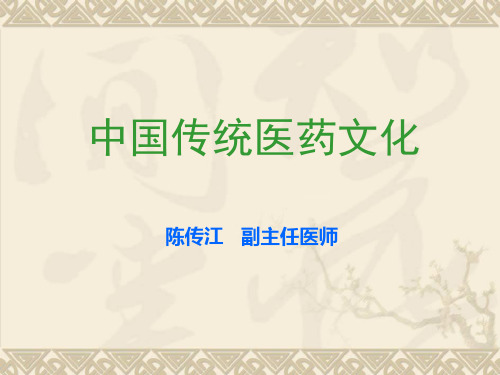
四、什么是中国传统文化?
中国传统文化是中华文明演化而汇集成的一种反映民族特质和风貌 的民族文化,是民族历史上各种思想文化、观念形态的总体表征,是指 居住在中国地域内的中华民族及其祖先所创造的、为中华民族世世代代 所继承发展的、具有鲜明民族特色的、历史悠久、内涵博大精深、传统 优良的文化。简单来说,就是通过不同的文化形态来表示的各种民族文 明,风俗,精神的总称。
(二)义理之学
《礼记· 礼器》“义理,礼之文也。” 汉指经义名理。《汉书· 刘歆传》“及歆治《左 氏》……由是章句,义理备焉。” 宋后,称讲求儒家经义,探究名理的学问为“义 理之学”。 现指研究国学的思想理论、内涵精神之学, 涵盖 儒释道诸子之学。
(三)经世之学
读书治学的目的,有内外两端,向内讲究修身 养性,发展完善的人性,向外则主张贡献服务于 社会人群,如此才能将知识转化为有用之学。如 果说义理之学为体的话,那么经世之学便为用。 传统的经世之学借鉴现代科学的分类方法可以 分列为下述三项: 1.自然科学 2.社会科学 3.美情趣,它们属于不
可见的隐性文化。包括文学、哲学、政治等方面内容。
三、文化的层次结构
• 一是物态文化层:由物化的知识力量构成,是人的物质生产 活动及其产品的总和,是可感知的、具有物质实体的文化事 物。 • 二是制度文化层:由人类在社会实践中建立的各种社会规范 构成。包括社会经济制度婚姻制度、家族制度、政治法律制 度、家族、民族、国家、经济、政治、宗教社团、教育、科 技、艺术组织等。 • 三是行为文化层:以民风民俗形态出现,见之于日常起居动 作之中,具有鲜明的民族、地域特色。 • 四是心态文化层:由人类社会实践和意识活动中经过长期蕴 育而形成的价值观念、审美情趣、思维方式等构成,是文化 的核心部分。
中医翻译
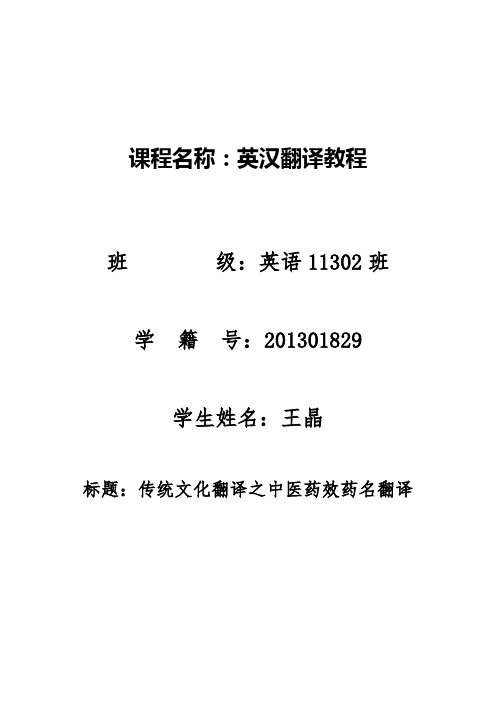
课程名称:英汉翻译教程班级:英语11302班学籍号:201301829学生姓名:***标题:传统文化翻译之中医药效药名翻译传统文化翻译之中医药效药名翻译王晶摘要中医是中华文化的瑰宝,源远流长,自成体系,富有浓厚的传统文化特色,而中药学则是中医学的一个重要分支。
中药饮片的种类数以千计,若加上纷繁的异名,别称,药名则有数万之众。
在如此众多的药名中,蕴涵着大量古代传统文化的信息,使得中药药名及其药效的翻译成为传统文化翻译中的一大难点。
近年来,中医药国际交流取得了长足进步,国际市场上对中医药认可和需求日益扩大。
然而,长期以来,中药名及其功效语的汉英翻译存在着不规范、不够准确的问题,甚至还存在着严重的漏译、错译现象。
如何将中医翻译得准确,使外国人明白和正确理解中医内容,这便是当今中医翻译界要解决的一个重要问题。
本文旨在从译词对等及中医的哲学文化角度分析总结中医药效药名的翻译模式及方法。
关键词:传统文化翻译中医药翻译译词对等翻译策略及方法中医中药概况简介中医是在古代朴素的唯物论和自发的辨证法思想指导下,通过长期医疗实践逐步形成并发展成的医学理论体系。
中医学以阴阳五行作为理论基础,将人体看成是气、形、神的统一体,通过“望闻问切”四诊合参的方法,探求病因、病性、病位、分析病机及人体内五脏六腑、经络关节、气血津液的变化、判断邪正消长,进而得出病名,归纳出证型,以辨证论治原则,制定“汗、吐、下、和、温、清、补、消”等治法,使用中药、针灸、推拿、按摩、拔罐、气功、食疗等多种治疗手段,使人体达到阴阳调和而康复。
中医药也叫汉族医药,它是中华民族的宝贵财富,为中华民族的繁衍昌盛做出了巨大贡献。
中药是指在中医理论指导下用于预防、诊断、治疗疾病或调节人体机能的药物。
多为植物药,也有动物药、矿物药及部分化学、生物制品类药物。
中药按加工工艺分为中成药、中药材。
中国医药学已有数千年的历史,是中国人民长期同疾病作斗争的极为丰富的经验总结。
中医药名词英文翻译18(中医骨伤科学)

18.001骨折fracture骨的完整性或连续性受到破坏所引起的,以疼痛、肿胀、青紫、功能障碍、畸形及骨擦音等为主要表现的疾病。
18.002损伤injury外界各种创伤因素作用于人体,引起皮肉、筋骨、脏腑等组织结构破坏,及其局部和全身反应疾病的统称。
18.003青枝骨折greenstick fracture仅有部分骨质和骨膜被拉长、皱褶或破裂,常有成角、弯曲畸形,如青嫩的树枝被折断状的一类骨折。
多见于儿童。
18.004裂缝骨折fissured fracture以骨折间隙呈裂缝或线状,骨折片无移位,形似瓷器上的裂纹为主要表现的一类骨折。
18.005锁骨骨折fracture of clavicle锁骨部发生的骨折。
18.006肩胛骨骨折fracture of scapula肩胛骨部发生的骨折。
18.007肱骨外科颈骨折fracture of surgicalneck of humerus以局部肿胀、疼痛、压痛和伤肢纵轴叩击痛,肩关节活动功能障碍,上臂上段可见瘀斑等为主要表现,发生在肱骨解剖颈下2~3cm处的骨折。
18.008肱骨大结节骨折fracture of greatertuberosity of humerus以局部疼痛、肿胀,肩关节活动障碍,尤以肩外展及外旋为甚,活动时疼痛加重,压痛明显,有移位骨折,可扪及异常活动及骨擦音等为主要表现,发生在肱骨大结节部的骨折。
18.009肱骨干骨折fracture of shaft ofhumerus 以患臂肿胀、疼痛、不能抬举,且有明显的压痛和纵轴叩击痛等为主要表现,发生在肱骨外科颈以下至内外髁上2cm处的骨折。
18.010肱骨髁上骨折supracondylar fractureof humerus 以肘部疼痛,肿胀明显甚至有张力水泡,肘部畸形,活动障碍为主要表现,发生在肱骨下端肱骨内、外上髁上方2cm以内的骨折。
18.011肱骨髁间骨折intercondylar fractureof humerus 以肘部肿胀、疼痛、畸形,肘关节呈半屈曲位,前臂旋前,肘部三角关系改变,稍用力掐捏肘部即有骨擦音为主要表现,发生在肱骨内、外髁之间及其邻近部位的骨折。
中医药名词英文翻译07(方剂学)

07.001方剂prescription,recipe,formula 07.002处方法prescribing method07.003配伍synergy07.004药对couplet medicines07.005方论discourse on prescription 07.006经方classical prescriptions 07.007时方non-classical prescriptions 07.008单方simple recipe07.009复方compound recipe07.010验方experiential effective recipe 07.011秘方secret recipe07.012中成药traditional Chinese patentmedicines and simplepreparations07.013君药sovereign drug07.014臣药minister drug07.015佐药assistant drug07.016佐助药supplementary drug07.017佐制药supplementary inhibitorymedicines07.018反佐药contrary drug07.019使药envoy drug07.020调和药harmonizing drug07.021引经药channel ushering drug 07.022剂型preparation07.023汤剂decoction07.024浓缩煎剂concentrated decoction 07.025膏滋oral thick paste07.026片剂tablet07.027泡腾片effervescent tablet07.028线剂thread formula07.029条剂stripe formula07.030露剂distillate formula07.031膏药plaster;medicinal paste 07.032软膏剂ointment07.033散剂powder07.034丸剂pill, bolus07.035蜜丸honeyed pill07.036水丸watered pill07.037水蜜丸water-honeyed pill 07.038糊丸flour and water paste pill 07.039浓缩丸concentrated pill07.040蜡丸wax pill07.041微丸mini-pill07.042滴丸剂dripping pill07.043颗粒剂granules07.044胶囊剂capsule07.045硬胶囊剂hard capsule07.046软胶囊剂soft capsule07.047微囊剂micro-capsule07.048茶剂medicinal tea07.049糕剂cake07.050栓剂suppository07.051搽剂liniment07.052锭剂lozenge07.053[烟]熏剂smoke fumigant 07.054曲剂fermented medicine 07.055胶剂gel07.056气雾剂aerosol07.057喷雾剂spray07.058灌肠剂enema07.059灸剂moxibustion formula 07.060熨剂compression formula 07.061合剂mixture07.062酊剂tincture07.063酒剂wine07.064浸膏剂extract07.065流浸膏剂liquid extract07.066口服液oral liquid07.067糖浆剂syrup07.068注射剂injection07.069乳剂emulsion07.070滴鼻剂nasal drop07.071滴眼剂eye drop07.072滴耳剂ear drop07.073水煎decoct with water 07.074酒煎decoct with wine 07.075先煎decocted earlier 07.076后下decocted later07.077包煎wrap-boiling07.078另煎decocted separately07.079烊化melt07.080兑入mix07.081生汁兑入mix with fresh juice07.082溶化dissolve07.083冲服administered after dissolved 07.084火候optimal fire07.085文火mild fire07.086武火strong fire07.087临睡服administered before bed time 07.088饭前服administered before meal; a.c.;ante cibum07.089饭后服administered after meal ; p.c.;post cibum07.090空腹服administered at empty stomach 07.091热服administered hot07.092温服administered warm07.093冷服administered cold07.094噙化administered under tongue 07.095顿服administered at draught07.096分服taken separately07.097频服taken frequently07.098药引medicinal usher07.099解表剂superficies-resolving formula 07.100辛温解表剂formula for relieving superficiessyndrome with pungent andwarm natured drugs07.101辛凉解表剂formula for relieving superficiessyndrome with pungent and coolnatrued drugs07.102扶正解表剂formula for strengthening bodyresistance and relievingsuperficies07.103表里双解剂formula for relieving bothsuperficial and internal disorders 07.104解表清里剂formula for relieving superficiesand clearing interior07.105解表温里剂formula for relieving superficiesand warming interior07.106解表通里剂formula for relieving superficiesand catharsis07.107和解少阳剂reconciling shaoyang formula 07.108清热剂heat-clearing formula07.109清气分热剂formula for clearing heat at qilevel07.110清营凉血剂formula for clearing nutrient leveland cooling blood07.111清热解毒剂formula for clearing heat andremoving toxicity07.112清脏腑热剂formula for clearing heat inviscerae07.113清热解暑剂formula for clearing heat andanti-summer- heat07.114清虚热剂formula for clearing asthenicfever07.115温里剂warming interior formula07.116温中散寒剂formula for warming interior fordispersing cold07.117回阳救逆剂formula for restoring yang andrescuing patient from collapse 07.118温经散寒剂formula for warming channel fordispersing cold07.119泻下剂formula for purgation07.120寒下剂cold cathartic formula07.121温下剂warm cathartic formula07.122润下剂moistened cathartic formula 07.123逐水剂drastic diuretics formula07.124补益剂supplementing [and boosting]formula07.125补气剂qi-supplementing formula07.126补血剂blood-supplementing formula07.127气血双补剂formula for benefiting both qi andblood07.128补阴剂yin-supplementing formula07.129补阳剂yang-supplementing formula 07.130阴阳并补剂formula for benefiting both yinand yang07.131固涩剂astringent formula07.132固表止汗剂formula for consolidatingsuperficies for arresting sweating 07.133敛肺止咳剂formula for astringing lung forrelieving cough07.134涩肠固脱剂formula for astringing intestineand arresting proptosis07.135涩精止遗剂formula for astringingspermatorrhea07.136固崩止带剂formula for arresting leucorrheaand metrorrhagia07.137安神剂sedative;tranquillizing formula 07.138消食剂digestive formula07.139开窍剂formula for resuscitation07.140凉开剂cold formula for resuscitation 07.141温开剂warm formula for resuscitation 07.142理气剂carminative formula;qi regulatedformula07.143行气剂formula for activating qi flowing 07.144降气剂formula for descending qi07.145理血剂blood-regulating formula07.146活血剂blood-activating formula07.147止血剂blood-stanching formula07.148治风剂formula for wind disorder07.149疏散外风剂formula for dispersing externalwind07.150平熄内风剂formula for calming downinternal wind07.151祛湿剂desiccating formula07.152和胃燥湿剂formula for harmonizing thestomach and drying dampness 07.153清热祛湿剂formula for clearing heat andeliminating dampness07.154利水渗湿剂formula for diuresis and diffusingdampness07.155温化水湿剂formula for warmly resolvingwatery dampness07.156祛痰剂phlegm-expelling formula07.157温燥化痰剂formula for resolving phlegmwith warm drugs07.158清润化痰剂formula for resolving phlegmwith clear-moistening drugs 07.159治风化痰剂formula for resolving phlegmwith arresting wind07.160驱虫剂anti-helminthic formula07.161涌吐剂emetic formula07.162一贯煎yiguan decoction07.163丁香柿蒂汤dingxiang shidi decoction07.164七宝美髯丹qibao meiran mini-pills07.165七厘散qili powder;qili san07.166九仙散jiuxian powder07.167九味羌活汤jiuwei qianghuo decoction07.168二至丸erzhi pills07.169二妙散ermiao powder07.170二陈汤erchen decoction07.171八正散bazheng powder07.172八珍汤bazhen decoction07.173十灰散shihui powder07.174十枣汤shizao decoction07.175三子养亲汤sanzi yangqin decoction 07.176三甲复脉汤sanjia fumai decoction 07.177三仁汤sanren decoction07.178三物备急丸sanwu beiji pill07.179川芎茶调散chuanxiong chatiao powder;chuanxiong chatiao san07.180大补阴丸da buyin pill;da buyin wan 07.181大定风珠dadingfengzhu pill07.182大建中汤dajianzhong decoction07.183大承气汤dachengqi decoction07.184大柴胡汤dachaihu decoction07.185大秦艽汤daqinjiao decoction07.186大黄牡丹汤dahuang mudan decoction 07.187大黄附子汤dahuang fuzi decoction 07.188小建中汤xiaojianzhong decoction 07.189小金丹xiaojin mini-pills07.190小青龙汤xiaoqinglong decoction 07.191小活络丹xiaohuoluo mini-pills 07.192小柴胡汤xiaochaihu decoction 07.193小续命汤xiaoxuming decoction 07.194小蓟饮子xiaoji drink07.195小儿回春丹xiao'er huichun mini-pills 07.196乌梅丸wumei pills07.197五仁丸wuren pills07.198五皮饮wupi drink07.199五味消毒饮wuwei xiaodu drink07.200五苓散wuling powder;wuling san 07.201五积散wuji powder07.202六一散liuyi powder; liuyi san07.203六味地黄丸liuwei dihuang pill;liuweidihuang wan07.204内补黄芪汤neibu huangqi decoction07.205化虫丸huachong pill07.206升麻葛根汤shengma gegen decoction 07.207天王补心丹tianwang buxin mini-pills07.208天台乌药散tiantai wuyao powder07.209天麻钩藤饮tianma gouteng drink07.210木香槟榔丸muxiang binlang pills;muxiangbinlang wan07.211止痉散zhijing powder07.212止嗽散zhisou powder07.213贝母瓜蒌散beimu gualou powder07.214苇茎汤weijing decoction07.215仙方活命饮xianfang huoming drink07.216加减葳蕤汤jiajian weirui decoctionbanxia baizhu tianma decoction 07.217半夏白术天麻汤07.218半夏泻心汤banxia xiexin decoction07.219半夏厚朴汤banxia houpu decoction07.220右归丸yougui pill07.221右归饮yougui drink07.222四君子汤sijunzi decoction07.223四妙勇安汤simiao yong'an decoction 07.224四物汤siwu decoction07.225四神丸sishen pill;sishen wan 07.226四逆汤sini decoction;sini tang 07.227四逆散sini powder07.228失笑散shixiao powder07.229左归丸zuogui pill07.230左归饮zuogui drink07.231左金丸zuojin pill;zuojin wan07.232布袋丸budai pill07.233平胃散pingwei powder07.234归脾汤guipi decoction07.235玉女煎yunü decoction07.236玉屏风散yupingfeng powder07.237玉真散yuzhen powder;yuzhen san 07.238瓜蒂散guadi powder07.239甘麦大枣汤ganmai dazao decoction 07.240甘露消毒丹ganlu xiaodu micropills07.241生化汤shenghua decoction07.242生脉散shengmai powder; shengmaisan07.243白头翁汤baitouweng decoction07.244白虎汤baihu decoction07.245石斛夜光丸shihu yeguang pills;shihuyeguang wan07.246龙胆泻肝汤longdan xiegan decoction 07.247再造散zaizao powder;zaizao san 07.248地黄饮子dihuang drink07.249安宫牛黄丸angong niuhuang pills;angongniuhuang wan07.250导赤散daochi powder07.251当归六黄汤danggui liuhuang decoction 07.252当归四逆汤danggui sini decoction 07.253当归补血汤danggui buxue decoction 07.254朱砂安神丸zhusha anshen pills07.255百合固金汤baihe gujin decoction 07.256竹叶石膏汤zhuye shigao decoction 07.257至宝丹zhibao mini-pills07.258舟车丸zhouche pills07.259芍药汤shaoyao decoction07.260血府逐瘀汤xuefu zhuyu decoction 07.261防己黄芪汤fangji huangqi decoction07.262防风通圣散fangfeng tongsheng powder 07.263阳和汤yanghe decoction07.264吴茱萸汤wuzhuyu decoction07.265完带汤wandai decoction07.266杏苏散xingsu powder07.267牡蛎散muli powder07.268羌活胜湿汤qianghuo shengshi decoction 07.269苍耳散cang'er powder07.270苏子降气汤suzi jiangqi decoction07.271苏合香丸suhexiang pills;suhexiang wan07.272补中益气汤buzhongyiqi decoction07.273补阳还五汤buyang huanwu decoction 07.274补肺阿胶汤bufei ejiao decoction07.275连朴饮lianpu drink07.276麦门冬汤maimendong decoction07.277龟鹿二仙胶guilu erxian glue07.278参苏饮shensu drink07.279参附汤shenfu decoction07.280参苓白术散shenling baizhu powder;shenling baizhu san07.281固冲汤guchong decoction07.282固经丸gujing pills;gujing wan 07.283定志丸dingzhi pills07.284定喘汤dingchuan decoction 07.285定●丸dingjian pills07.286实脾散shipi powder07.287易黄汤yihuang decoction07.288泻白散xiebai powder07.289炙甘草汤zhigancao decoction07.290肥儿丸fei'er pills;fei'er wan 07.291肾气丸shenqi pills07.292苓桂术甘汤linggui zhugan decoction 07.293败毒散baidu powder07.294金沸草散jinfeicao powder07.295金铃子散jinlingzi powder07.296金锁固精丸jinsuo gujing pills07.297青蒿鳖甲汤qinghao biejia decoction 07.298保和丸baohe pills;baohe wan 07.299养阴清肺汤yangyin qingfei decoction 07.300厚朴温中汤houpu wenzhong decoction07.301咳血方kexue formula07.302复元活血汤fuyuan huoxue decoction;fuyuan huoxue tang07.303枳术丸zhizhu pills;zhizhu wan07.304枳实导滞丸zhishi daozhi pills;zhishi daozhiwan07.305枳实消痞丸zhishi xiaopi pillszhishi xiebai guizhi decoction 07.306枳实薤白桂枝汤07.307栀子豉汤zhizichi decoction07.308济川煎jichuan decoction07.309封髓丹feng sui micropills07.310牵正散qianzheng powder07.311独活寄生汤duhuo jisheng decoction07.312茯苓丸fuling pills07.313茵陈五苓散yinchen wuling powder07.314茵陈蒿汤yinchenhao decoction07.315香苏散xiangsu powder07.316香连丸xianglian pills;xianglian wan 07.317香薷散xiangru powder07.318凉膈散liangge powder07.319柴胡疏肝散chaihu shugan powder07.320柴葛解肌汤chaige jieji decoction07.321桂附地黄丸guifu dihuang pills;guifudihuang wan07.323桂枝茯苓丸guizhi fuling pills;guizhi fulingwan07.324桑杏汤sangxing decoction07.325桑菊饮sangju drink07.326桑螵蛸散sangpiaoxiao powder07.327消风散xiaofeng powder07.328益胃汤yiwei decoction07.329真人养脏汤zhenren yangzang decoction07.331逍遥散xiaoyao powder07.332透脓散tounong powder07.333救急稀涎散jiuji xixian powder07.334旋覆代赭石汤xuanfu daizheshi decoction 07.335清气化痰丸qingqi huatan pills07.336清络饮qingluo drink07.337清胃散qingwei powder07.338清骨散qinggu powder07.339清营汤qingying decoction07.340清暑益气汤qingshu yiqi decoction 07.341清瘟败毒散qingwen baidu powder 07.342清燥救肺汤qingzao jiufei decoction07.343猪苓汤zhuling decoction07.344理中汤lizhong decoction07.345羚角钩藤汤lingjiao gouteng decoction07.346萆薢分清饮bixie fenqing drink 07.347银翘散yinqiao powder 07.348麻子仁丸maziren pills07.349麻黄汤mahuang decoction07.350麻黄杏仁甘草石膏汤mahuang xingren gancao shigao decoction07.351黄土汤huangtu decoction07.352黄连解毒汤huanglian jiedu decoction 07.353普济消毒饮puji xiaodu drink07.355温胆汤wendan decoction 07.356温脾汤wenpi decoction07.357犀角地黄汤xijiao dihuang decoction 07.358疏凿饮子shuzuo drink07.359痛泻要方tongxieyao formula 07.360紫雪zixue powder;zixue 07.361葛根汤gegen decoction07.362葛根芩连汤gegen qinlian decoction 07.363葱豉汤congchi decoction 07.364越鞠丸yueju pills;yueju wan07.366槐花散huaihua powder07.367蒿芩清胆汤haoqin qingdan decoction 07.368磁朱丸cizhu pills07.369酸枣仁汤suanzaoren decoction07.370镇肝熄风汤zhengan xifeng decoction;zhengan xifeng tang07.371橘皮竹茹汤jupi zhuru decoction07.372橘核丸juhe pills07.373礞石滚痰丸mengshi guntan pills;mengshiguntan wan07.374藿香正气散huoxiang zhengqi powder07.375鳖甲煎丸biejiajian pills07.376蠲痹汤juanbi decoction07.377乙肝宁颗粒yiganning granules07.378七制香附丸qizhi xiangfu pills07.379八正合剂bazheng mixture;bazheng heji 07.380九华膏jiuhua plaster07.381人丹rendan mini-pills07.382人参再造丸renshen zaizao pills07.383人参养荣丸renshen yangrong pills;renshenyangrong wan07.384人参健脾丸renshen jianpi pills;renshenjianpi wan07.385八珍益母丸bazhen yimu pills;bazhen yimuwan07.386十全大补丸shiquan dabu pills;shiquan dabuwan07.387十香返生丸shixiang fansheng pills;shixiangfansheng wan07.388十滴水shidishui tincture07.389万氏牛黄清心丸wanshi niuhuang qingxin pills;wanshi niuhuang qingxin wan07.390万应锭wanying troches;wanying ding 07.391三七片sanqi tablets07.392三七伤药片sanqi shangyao tablets;sanqishangyao pian07.393三九胃泰sanjiu weitai capsules07.394三黄片sanhuang tablets;sanhuang pian 07.395三黄膏sanhuang plaster07.396上清丸shangqing pills07.397千柏鼻炎片qianbai biyan tablets;qianbaibiyan pian07.398口炎清颗粒kouyanqing granules07.399大山楂丸dashanzha bolus; dashanzhawan07.400大活络丹dahuoluo pills07.401大黄●虫丸dahuang zhechong pills;dahuang zhechong wan07.402小儿至宝丸xiao'er zhibao pills;xiao'erzhibao wan07.403小儿肝炎颗粒xiao'er ganyan granules;xiao'erganyan keli07.404小儿感冒颗粒xiao'er ganmao granules;xiao'erganmao keli07.405小金丸xiaojin pills;xiaojin wan 07.406川贝枇杷糖浆chuanbei pipa syrup;chuanbeipipa tangjiang07.407马应龙麝香痔疮膏mayinglong shexiang zhichuang ointments;mayinglong shexiang zhichuang gao07.408丹参注射液danshen injections07.409丹栀逍遥丸danzhi xiaoyao pills07.410乌鸡白凤丸wuji baifeng pills;wuji baifengwan07.411云南白药yunnan baiyao powder07.412五子衍宗丸wuzi yanzong pills; wuziyanzong wan07.413五仁润肠丸wuren runchang pills07.414五福化毒丸wufu huadu pills;wufu huaduwan07.415元胡止痛片yuanhu zhitong tablets;yuanhuzhitong pian07.416六合定中丸liuhe dingzhong pills;liuhedingzhong wan07.417六君子丸liujunzi pills07.418六神丸liushen pills07.419内消瘰疬丸neixiao luoli pills07.420午时茶颗粒wushicha granules;wushichakeli07.421双黄连口服液shuanghuanglian mixture;shuanghuanglian koufuye07.422天麻丸tianma pills;tianma wan07.423开胸顺气丸kaixiong shunqi pills;kaixiongshunqi wan07.424心脉通片xinmaitong tablets07.425木瓜丸mugua pills;mugua wan07.426木香顺气丸muxiang shunqi pills07.427气滞胃痛颗粒qizhi weitong granules07.428牛黄上清丸niuhuang shangqing pills;niuhuang shangqing wan07.429牛黄至宝丸niuhuang zhibao pills07.430牛黄抱龙丸niuhuang baolong pills;niuhuang baolong wan07.431牛黄降压胶囊niuhuang jiangya capsules07.432牛黄清心丸niuhuang qingxin pills;niuhuangqingxin wan07.433牛黄蛇胆川贝液niuhuang shedan chuanbei mixture07.434牛黄解毒片niuhuang jiedu tablets;niuhuang jiedu pian07.435风油精wind medicated oil07.436半硫丸banliu pills07.437去腐生肌散qufu shengji powder07.438史国公药酒shiguogong wine07.439正骨水zhenggu mixture;zhenggu shui07.440生肌玉红膏shengji yuhong plaster07.441生脉注射液shengmai injections07.442白带丸baidai pills;baidai wan07.443石斛明目丸shihu mingmu pills07.444艾附暖宫丸aifu nuangong pills;aifunuangong wan07.445伤湿止痛膏shangshi zhitong plaster;shangshi zhitong gao07.446冰硼散bingpeng powder; bingpeng san 07.447华佗再造丸huatuo zaizao pills;huatuozaizao wan07.448地奥心血康胶囊di'ao xinxuekang capsules;di'ao xinxuekang jiaonang07.449地榆槐角丸diyu huaijiao pills07.450壮骨关节丸zhuanggu guanjie pills;zhuanggu guanjie wan07.451如意金黄散ruyi jinhuang powder;ruyijinhuang san07.452妇乐颗粒fule granules07.453妇炎平胶囊fuyanping capsules07.454安坤赞育丸ankun zanyu pills;ankun zanyuwan07.455安神补心丸anshen buxin pills;anshen buxinwan07.456当归龙荟丸danggui longhui pills;dangguilonghui wan07.457当归流浸膏danggui extract;danggui liujingao07.458耳聋左慈丸erlong zuoci pills;erlong zuociwan07.459芎菊上清丸xiongju shangqing pills;xiongjushangqing wan07.460西瓜霜润喉片xiguashuang runhou tablets;xiguashuang runhou pian07.461贞芪扶正颗粒zhenqi fuzheng granules07.462防风通圣丸fangfeng tongsheng pills;fangfeng tongsheng wan07.463利胆排石片lidan paishi tablets;lidan paishipian07.464坎离砂kanlisha coarse sand granules;kanlisha07.465尪痹颗粒wangbi granules07.466尿塞通片niaosaitong tablets07.467抗骨增生丸kanggu zengsheng pills; kangguzengsheng wan07.468更年安片gengnian'an pills;gengnian'anpian07.469杏仁止咳糖浆xingren zhike syrup;xingrenzhike tangjiang07.470杞菊地黄丸qiju dihuang pills;qiju dihuangwan07.471良附丸liangfu pills;liangfu wan07.472补肾固齿丸bushen guchi pills;bushen guchiwan07.473阿魏化痞膏awei huapi plaster;awei huapigao07.474附子理中丸fuzi lizhong pills;fuzi lizhongwan07.475龟龄集guilingji capsules;guilingji 07.476乳癖消片rupixiao tablets;rupixiao pian 07.477京万红jingwanhong soft plaster07.478刺五加片ciwujia tablets;ciwujia pian 07.479国公酒guogong wine;guogong jiu 07.480季德胜蛇药片jidesheng sheyao tablets07.481拔毒生肌散badu shengji powder07.482拨云退翳丸boyun tuiyi pills;boyun tuiyiwan07.483明目上清丸mingmu shangqing pills07.484明目地黄丸mingmu dihuang pills;mingmudihuang wan07.485板蓝根颗粒banlangen granules;banlangenkeli07.486河车大造丸heche dazao pills;heche dazaowan07.487狗皮膏goupi plaster;goupi gao07.488知柏地黄丸zhibai dihuang pills;zhibaidihuang wan07.489金银花露jinyinhua distillate07.490青黛散qingdai powder07.491驻车丸zhuche pills;zhuche wan07.492养血安神丸yangxue anshen pills07.493养胃舒胶囊yangweishu capsules07.494冠心苏合丸guanxin suhe pills;guanxin suhewan07.495前列通片qianlietong tablets07.496复方丹参片compound danshen tablets;fufang danshen pian07.497复方丹参注射液compound danshen injections 07.498复方丹参滴丸compound danshen drippingpills;fufang danshen diwan 07.499复方胆通片compound dantong tablets07.500复方草珊瑚含片compound caoshanhu tablets;fufang caoshanhu hanpian07.501急支糖浆jizhi syrup;jizhi tangjiang07.502柏子养心丸baizi yangxin pills;baizi yangxinwan07.503活血止痛散huoxue zhitong powder;huoxuezhitong san07.504济生肾气丸jisheng shenqi pills;jishengshenqi wan07.505珍珠明滴眼液zhenzhu ming eye drops07.506穿心莲片chuanxinlian tablets;chuanxinlian pian07.507绞股兰总苷片jiaogulan total glucoside tablets 07.508胃苏颗粒weisu granules07.509胆石通胶囊danshitong capsules07.510茴香橘核丸huixiang juhe pills;huixiang juhewan07.511重感灵片zhongganling tablets07.512首乌丸shouwu pills;shouwu wan 07.513香连片xianglian tablets;xianglian pian 07.514香砂六君丸xiangsha liujun pills;xiangshaliujun wan07.515香砂养胃丸xiangsha yangwei pills;xiangshayangwei wan07.516香砂枳术丸xiangsha zhizhu pills;xiangshazhizhu wan07.517骨刺丸guci pills07.518柴胡口服液chaihu oral liquid;chaihukoufuye07.519桂附理中丸guifu lizhong pills;guifu lizhongwan07.520消咳喘糖浆xiaokechuan syrup;xiaokechuantangjiang07.521消栓再造丸xiaoshuan zaizao pills07.522消栓通络片xiaoshuan tongluo tablets;xiaoshuan tongluo pian07.523消痔灵xiaozhiling injections07.524益元散yiyuan powder;yiyuan san 07.525益母草膏yimucao paste;yimucao gao 07.526脏连丸zanglian pills;zanglian wan 07.527脑立清丸naoliqing pills;naoliqing wan07.528通关散tongguan powder;tongguan san 07.529通宣理肺丸tongxuan lifei pills;tongxuanlifei wan07.530速效救心丸suxiao jiuxin pills07.531铁笛丸tiedi pills07.532排石颗粒paishi granules;paishi keli 07.533清凉油qingliang oil07.534清开灵口服液qingkailing oral liquid;qingkailing koufuye07.535清开灵注射液qingkailing injections07.536清咽丸qingyan pills07.537紫金锭zijin troches;zijin ding07.538紫草膏zicao soft plaster;zicao gao 07.539蛤蚧定喘丸gejie dingchuan pills;gejiedingchuan wan07.540越鞠保和丸yueju baohe pills07.541跌打万花油dieda wanhua oil07.542跌打丸dieda pills;dieda wan07.543锁阳固精丸suoyang gujing pills;suoyanggujing wan07.544愈风宁心片yufeng ningxin tablets;yufengningxin pian07.545新清宁片xinqingning tablets;xinqingningpian07.546槐角丸huaijiao pills;huaijiao wan 07.547雷公藤片leigongteng tablets07.548鲜竹沥fresh bamboo sap07.549鼻炎片biyan tablets;biyan pian07.550鼻咽清毒颗粒biyan qingdu granules07.551鼻窦炎口服液bidouyan mixture;bidouyankoufuye07.552橘红丸juhong pills;juhong wan07.553藏青果喉片zangqingguo tablets07.554黛蛤散daige powder;daige san07.555癣湿药水xuanshi solution;xuanshiyaoshui07.556藿胆丸huodan pills;huodan wan07.557麝香保心丸shexiang baoxin pills;shexiangbaoxin wan07.558麝香追风膏shexiang zhuifeng plaster07.559麝香祛痛气雾剂shexiang qutong aerosol;shexiang qutong qiwuji在辨证、辨病,确定立法的基础上,根据组方原则和结构,选择适宜药物组合而成的药方和制剂。
中医英译中的问题_难点与原则
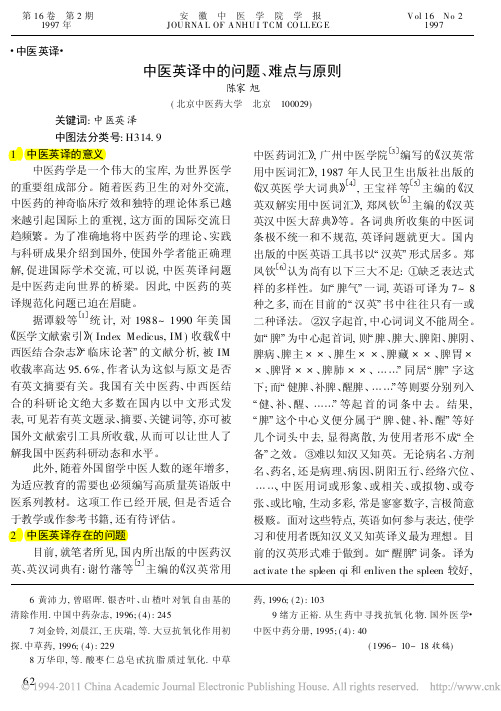
第16卷 第2期 安 徽 中 医 学 院 学 报 V ol16 N o2 1997年 JOU RNA L OF A NHU I T CM CO LL EG E 1997中医英译中医英译中的问题、难点与原则陈家旭(北京中医药大学 北京 100029)关键词:中医英泽中图法分类号:H314.91 中医英译的意义中医药学是一个伟大的宝库,为世界医学的重要组成部分。
随着医药卫生的对外交流,中医药的神奇临床疗效和独特的理论体系已越来越引起国际上的重视,这方面的国际交流日趋频繁。
为了准确地将中医药学的理论、实践与科研成果介绍到国外,使国外学者能正确理解,促进国际学术交流,可以说,中医英译问题是中医药走向世界的桥梁。
因此,中医药的英译规范化问题已迫在眉睫。
据谭毅等1!统计,对1988~1990年美国∀医学文献索引#(Index Medicus,IM)收载∀中西医结合杂志#∃临床论著%的文献分析,被IM 收载率高达95.6%,作者认为这似与原文是否有英文摘要有关。
我国有关中医药、中西医结合的科研论文绝大多数在国内以中文形式发表,可见若有英文题录、摘要、关键词等,亦可被国外文献索引工具所收载,从而可以让世人了解我国中医药科研动态和水平。
此外,随着外国留学中医人数的逐年增多,为适应教育的需要也必须编写高质量英语版中医系列教材。
这项工作已经开展,但是否适合于教学或作参考书籍,还有待评估。
2 中医英译存在的问题目前,就笔者所见,国内所出版的中医药汉英、英汉词典有:谢竹藩等2!主编的∀汉英常用中医药词汇#,广州中医学院3!编写的∀汉英常用中医词汇#,1987年人民卫生出版社出版的∀汉英医学大词典#4!,王宝祥等5!主编的∀汉英双解实用中医词汇#,郑凤钦6!主编的∀汉英英汉中医大辞典#等。
各词典所收集的中医词条极不统一和不规范,英译问题就更大。
国内出版的中医英语工具书以∃汉英%形式居多。
郑凤钦6!认为尚有以下三大不足:&缺乏表达式样的多样性。
中医药名词英文翻译03(中医基础理论)
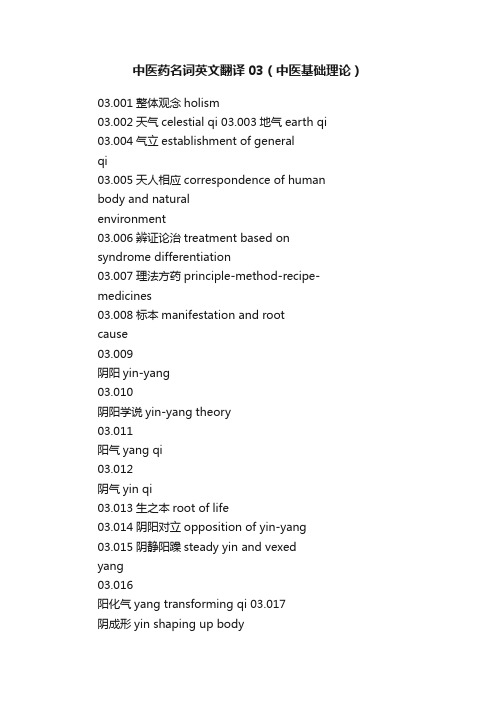
中医药名词英文翻译03(中医基础理论)03.001整体观念holism03.002天气celestial qi 03.003地气earth qi 03.004气立establishment of generalqi03.005天人相应correspondence of human body and naturalenvironment03.006辨证论治treatment based on syndrome differentiation03.007理法方药principle-method-recipe- medicines03.008标本manifestation and rootcause03.009阴阳yin-yang03.010阴阳学说yin-yang theory03.011阳气yang qi03.012阴气yin qi03.013生之本root of life03.014阴阳对立opposition of yin-yang03.015阴静阳躁steady yin and vexedyang03.016阳化气yang transforming qi 03.017阴成形yin shaping up body03.018阴阳互根mutual rooting of yin- yang03.019阴阳消长waxing and waning of yin-yang03.021重阳必阴extreme yang changing into yin03.022重阴必阳extreme yin changing into yang03.023阴平阳秘relative equilibrium of yin-yang03.024阴阳自和natural harmony of yin- yang03.025五行five phases03.026五行学说five phases theory03.027木wood03.028火fire03.029土earth03.030金metal03.031水water03.032木曰曲直wood characterized by bending andstraightening03.033火曰炎上fire characterized by flaring up03.034土爰稼穑earth characterized by sowing and reaping03.035金曰从革metal characterized by clearing and changing03.036水曰润下water characterized by moistening anddescending03.037五时five seasons 03.038五方five orientations 03.039五行相生mutual generation offive phases03.040母气mother qi 03.041子气child qi03.042母病及子illness of motherviscera affecting thechild one03.043子病及母illness of child visceraaffecting the mother one03.044木生火wood generating fire03.046土生金earth generating metal 03.047金生水metal generating water 03.048水生木water generating wood03.049五行相克mutual restriction offive phases03.050所胜being restrained03.051所不胜restraining03.052木克土wood restricting earth 03.053火克金fire restricting metal 03.054土克水earth restricting water 03.055水克火water restricting fire 03.056金克木metal restricting wood03.057五行相乘over-restriction of five phases03.058五行相侮counter-restriction of five phases03.059亢害承制restraining excessiveness to acquireharmony03.060制化restriction and generation03.061运气学说doctrine of five evolutive phases and sixclimatic factors03.062干支heavenly stems and earthly branches03.063甲子sixty-year cycle03.064运气five evolutive phasesand six climatic factors03.065五运five evolutive phases03.066六气six climatic factors 03.067主气host climatic qi 03.068客气guest climatic qi 03.069司天celestial manager qi 03.070在泉qi in the earth03.071主运host evolutive phase 03.072客运guest evolutive phase 03.073岁运year evolutive phase03.074客主加临guest climatic qi addingto fixed host qi03.075运气相合combined analysis offive evolutive phasesand six climatic factors03.076运气盛衰rise and fall of five evolutive phases and sixclimatic factors03.077天符coincidence of heavenlyqi03.078岁会yearly weather03.079平气normal climatic factors03.080运气太过excess of five evolutive phases and six climaticfactors03.081运气不及deficiency of five evolutive phases and sixclimatic factors03.082标本中气manifestation, rootcause and medial qi03.083脏腑zang-fu viscera脏象visceral manifestations03.085脏象学说theory of visceral manifestations03.086五脏five zang viscera03.087藏精气而不泻storing essence without03.088五神five emotions03.089五华five lustre03.090五体five body constituents 03.091五志five minds 03.092七情seven emotions03.093五液five humors03.094心heart03.095心包络pericardium03.096心气heart qi03.097心血heart blood03.098心阴heart yin03.099心阳heart yang03.100君火sovereign fire03.101心藏神heart storing spirit03.102心主血脉heart governing bloodand vessels03.103心开窍于舌heart opening at tongue03.104心恶热heart being averse toheat肺lung 03.106肺气lung qi肺阴lung yin03.108肺阳lung yang03.109肺主气lung governing qi03.110肺藏魄lung storing inferior spirit03.111肺朝百脉lung connecting all vessels03.112肺主治节lung governing management andregulation03.113肺主宣发lung governing diffusion03.114肺主肃降lung governing purification anddescending03.115肺司呼吸lung controlling breathing03.116肺主通调水道lung governing regulation of waterpassages03.117肺主皮毛lung governing skin and hair03.118肺开窍于鼻lung opening at nose03.119肺恶寒lung being averse to cold脾spleen 03.121脾气spleen qi 03.122脾阴spleen yin 03.123脾阳spleen yang03.124脾主运化spleen governingtransportation andtransformation03.125脾为后天之本spleen being acquiredfoundation03.126脾主升清spleen governingascending clear03.128脾主四肢spleen governing limbs 03.129脾主肌肉spleen governing muscles 03.130脾藏营spleen storing nutrients 03.131脾藏意spleen storing idea 03.132脾开窍于口spleen opening at mouth03.133脾喜燥恶湿spleen liking drynessand disliking dampness03.134胰pancreas 03.135肝liver03.136肝气liver qi 03.137肝血liver blood 03.138肝阴liver yin 03.139肝阳liver yang03.140肝主疏泄liver controllingconveyance anddispersion03.141肝主升发liver governingascending and dredging03.142肝为刚脏liver being bold andfirm viscera03.143肝体阴用阳liver being substantialyin and functional yang03.144肝主筋liver governing tendons 03.145肝藏血liver storing blood 03.146肝藏魂liver storing soul 03.147肝开窍于目liver opening at eye肝恶风liver being averse towind03.149肾kidney03.150命门vital gate03.151命门之火vital gate fire 03.152精室essence chamber 03.153 肾精kidney essence 03.154肾气kidney qi03.155肾阴kidney yin03.156肾阳kidney yang 03.157天癸tian gui03.158相火ministerial fire03.159肾为先天之本kidney being congenitalorigin03.160肾主封藏kidney governing storage 03.161肾主生殖kidney governing reproduction03.162肾主水液kidney governing water metabolism03.163肾主纳气kidney governing inspiration03.164肾藏精kidney storing essence 03.165 肾藏志kidney storing will 03.166肾主骨kidney governing bones 03.167肾开窍于耳kidney opening at ear03.168肾恶燥kidney being averse to dryness03.169六腑six fu viscera03.170传化物而不藏digesting and transporting food anddrink without storingessence03.171胆gallbladder 03.172胆气gallbladder qi 03.173胆汁bile03.174中清之腑fu-viscera with clearjuice03.175中正之官fu-viscera with decisive character03.176胃stomach03.177胃气stomach qi 03.178胃阴stomach yin 03.179胃阳stomach yang 03.180胃津stomach fluid 03.181水谷之海reservoir of food anddrink03.182胃主受纳stomach receiving food and drink03.183胃喜润恶燥spleen liking moistness and disliking dryness03.184小肠small intestine 03.185回肠ileum03.186受盛化物reservoir and transformation03.187分清泌浊separating clear and excreting turbid03.188大肠large intestine传导之官official of03.190膀胱bladder03.191膀胱气化functioning of bladder 03.192三焦sanjiao03.193上焦upper jiao03.194上焦如雾upper jiao being organof fogging03.195中焦middle jiao03.196中焦如沤middle jiao being organof soaking03.197下焦lower jiao03.198下焦如渎lower jiao being organof draining03.199奇恒之腑extraordinary fu-viscera 03.200脑brain03.201脑髓brain marrow03.202脑户door of brain03.203囟门fontanel03.204元神之府fu-viscera of mentalactivity03.205髓marrow03.206骨bone03.207髓之府fu-viscera of marrow 03.208骨度bone-length measurement 03.209脉vessel 03.210血之府house of blood03.211胞宫uterus; womb03.212胞脉uterine vessels03.213胞门uterine ostium03.214阴道vagina03.215月经menstruation胎衣placenta03.217脏腑相合interconnection of zang-fu viscera03.218心合小肠heart being connectedwith small intestine03.219肺合大肠lung being connectedwith large intestine03.220脾合胃spleen being connectedwith stomach03.221肝合胆liver being connectedwith gallbladder03.222肾合膀胱kidney being connectedwith bladder03.223心肾相交intercourse betweenheart and kidney03.224肝肾同源homogeny of liver andkidney03.225肺肾相生mutually promotion oflung and kidney03.226仓廪之本root of granary; spleenand stomach03.227经络channel; meridian经络学说channel theory03.229经脉channel03.230经气channel qi 03.231根结root and knot 03.232气街pathway of qi 03.233 四海four seas03.234十二经脉twelve regular channels;twelve regular meridians03.235手三阳经three yang channels of hand; three yangmeridians of hand03.236手三阴经three yin channels of hand; three yinmeridians of hand03.237足三阳经three yang channels of foot; three yinmeridians of foot03.238足三阴经three yin channels offoot; three yinmeridians of foot03.239手太阴肺经Taiyin Lung Channel of Hand; Taiyin LungMeridian of Hand03.240手阳明大肠经Yangming Large Intestine Channel of Hand;Yangming Large IntestineMeridian of Hand03.241足阳明胃经Yangming Stomach Channel of Foot; YangmingStomach Meridian ofFoot03.242足太阴脾经Taiyin Spleen Channel of Foot; Taiyin SpleenMeridian of Foot03.243手少阴心经Shaoyin Heart Channel of Hand; Shaoyin HeartMeridian of Hand03.244手太阳小肠经Taiyang Small IntestineChannel of Hand;Taiyang Small IntestineMeridian of Hand03.245足太阳膀胱经Taiyang Bladder Channel of Foot; TaiyangBladder Meridian ofFoot足少阴肾经Shaoyin Kidney Channelof Foot; Shaoyin KidneyMeridian of Foot03.247手厥阴心包经Jueyin Pericardium Channel of Hand; JueyinPericardium Meridian ofHand03.248手少阳三焦经Shaoyang Sanjiao Channel of Hand; ShaoyangSanjiao Meridian of Hand03.249足少阳胆经Shaoyang Gallbladder Channel of Foot;Shaoyang GallbladderMeridian of Foot03.250足厥阴肝经Jueyin Liver Channel of Foot; Jueyin LiverMeridian of Foot03.251奇经八脉Eight Extraordinary Channels; EightExtraordinary Meridians03.252督脉Governor Channel;Governor Vessel03.253任脉Conception Channel;Conception Vessel03.255带脉Belt Channel; BeltVessel03.256阴跷脉Yin Heel Channel; YinHeel Vessel03.257阳跷脉Yang Heel Channel; YangHeel Vessel03.258阴维脉Yin Link Channel; YinLink Vessel03.259阳维脉Yang Link Channel; YangLink Vessel03.260十四经fourteen channels03.261经别branched channel03.262经筋aponeurotic system 03.263皮部dermal parts03.264络脉collaterals03.265孙络tertiary collaterals 03.266浮络superficial collaterals 03.267别络connecting collaterals 03.268形physique03.269皮毛skin and hair03.270腠理striae and interstitialspace03.271玄府sweat pore03.272肌肉muscle筋(1)soft tissue (2)tendon03.274膜membrane03.275关节joint03.276百骸bones03.277完骨mastoid process 03.278枕骨occipital bone 03.279头颅骨skull03.280曲牙mandibular angle 03.281眉棱骨supra-orbital bone03.282辅骨(1)condyle (2)fibula andradius03.283高骨protruding bones 03.284交骨pubis bone03.285颈骨cervical vertebra 03.286髋骨hip bone03.287髋hip03.288上横骨manubrium of sternum 03.289尾闾骨coccyx03.290腰骨lumbar bone03.291手骨hand bone03.292合骨medial malleolus 03.293跖plantar03.294头head03.295精明之府house of intelligence 03.296腰waist03.297肾之府house of kidney03.298膝knee03.299筋之府house of tendons03.300膜原mo yuan; interpleuro-diaphragmatic space03.301膏肓gao huang; intercardiodiaphragmatic part03.302膈diaphragm 03.303脊spine03.304背back03.305胁肋lateral thorax 03.306腹abdomen03.309少腹lateral lower abdomen 03.310四极four limbs; four poles 03.311五官five [sense]apertures 03.312七窍seven orifices03.313九窍nine orifices03.314目eye03.315目系eye connector03.316五轮八廓five wheels and eightregions03.317肉轮flesh wheel03.318血轮blood wheel03.319气轮qi wheel03.320风轮wind wheel03.321水轮water wheel03.322眦canthus03.323目内眦inner canthus 03.324目外眦outer canthus 03.325目窠eye socket03.326眼带ocular band03.327目眶ocular orbit 03.328眼睑eyelid03.329睑弦palpebral margin 03.330睫毛eyelash03.331泪tear03.332泪泉lachrymal spring 03.333泪窍lachrymal punctum03.334白睛white eye, bulbarconjunctiva and sclera03.335黑睛black eye ,cornea andiris03.336瞳神pupil03.337虹彩iris03.338神水spiritual water, aqueous03.339晶珠crystal pearl; lens 03.340神膏vitreum03.341视衣visual cloth03.342舌tongue03.343舌系tongue connector;sublingual vessels andligament03.344口mouth 03.345唇lip 03.346齿tooth 03.347真牙genuine tooth;wisdomtooth03.348龈gum03.349腭palate03.350硬腭hard palate03.351软腭soft palate03.352咽pharynx03.353喉throat03.354喉核node of throat; tonsil 03.355喉关throat bar03.356喉底bottom of throatposterior pharyngealwall03.357颃颡nasopharynx 03.358鼻nose03.359明堂(1)nose (2)acupointchart03.360鼻准nasal apex03.361頞nasal root03.362耳ear03.363耳郭auricle03.364前阴external genitalia03.365宗筋(1)penis and testes (2)convergent tendon03.366茎penis精窍seminal orifice;03.368睾testicle03.369阴户vaginal door 03.370阴门vaginal orifice 03.371后阴anus03.372魄门anus03.373气qi03.374气化qi transformation 03.375气机qi movement 03.376升降出入ascending, descending, exiting and entering03.377气主煦之qi warming body03.378元气primordial qi03.379真气genuine qi03.380宗气pectoral qi03.381中气middle qi03.382卫气defensive qi03.383营气nutrient qi03.384脏腑之气qi of zang-fu viscera 03.385血blood03.386营血nutrient-blood03.387血主濡之blood being responsiblefor nurturing body03.388津液fluid03.389津clear fluid03.390液turbid fluid精(1)essence (2)semen。
中医药名词英文翻译09(推拿学)

09.001推拿massage推法和拿法的统称。
09.002手法manipulation操作者用手足刺激患病部位和运动肢体,达到治疗、保健作用的规范化技巧动作。
09.003推法pushing manipulation用指、掌或其他部位着力于人体一定部位或穴位上,作前后、上下、左右的直线或弧线推进的手法。
09.004拿法grasping manipulation以拇指与其他四指相对,捏住某一部位或穴位提拿揉捏的手法。
09.005●法rolling manipulation用手背部在体表一定部位作连续往返●动的手法。
09.006击打法striking manipulation用拳、指或掌背,或用器械击打患处而治疗疾病的手法。
09.007点穴法finger pointingmanipulation 以手指着力于某一穴位逐渐用力下压的一种以指代针的手法。
09.008弹拨法poking channelsmanipulation 用拇指或食指指腹相对,提捏肌肉或肌腱,再迅速放开,使其回缩,及以指端置于肌肉、肌腱等组织一侧,作与其走行垂直方向滑动的手法。
09.009按压法pressure manipulation用手掌、肘尖或足部着力在体表某一部位,逐渐用力下压的手法。
09.010摩法rubbing manipulation用手指或手掌附在体表的一定部位,作环行而有节奏抚摩的手法。
09.011揉捻法massaging and twistingmanipulation 用大鱼际、掌跟或指面于一定部位或某一穴位上,作轻柔和缓环旋运动的手法。
09.012摇法rotating and shakingmanipulation以关节为轴,使肢体作环转运动的手法。
09.013扳法pulling manipulation用双手向同一方向或相反方向用力,被动活动关节的手法。
09.014伸屈法stretching and flexingmanipulation 通过拔伸牵拉或屈曲折返活动,帮助受限关节被动运动的手法。
中医药名词英文翻译07(方剂学)
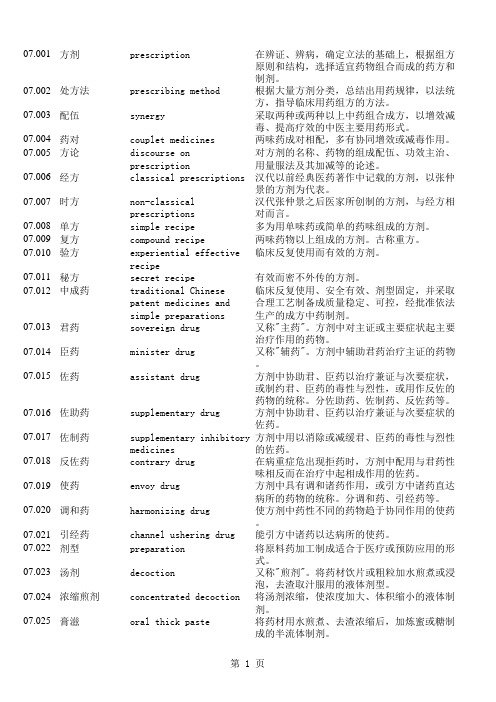
concentrated decoction 将汤剂浓缩,使浓度加大、体积缩小的液体制
剂。
oral thick paste
将药材用水煎煮、去渣浓缩后,加炼蜜或糖制
成的半流体制剂。
第1页
07.026 片剂
07.027 泡腾片 07.028 线剂 07.029 条剂
07.030 露剂 07.031 膏药 07.032 软膏剂 07.033 散剂 07.034 丸剂
07.055 胶剂 07.056 气雾剂
07.057 喷雾剂 07.058 灌肠剂 07.059 灸剂
07.060 熨剂 07.061 合剂 07.062 酊剂 07.063 酒剂 07.064 浸膏剂 07.065 流浸膏剂 07.066 口服液 07.067 糖浆剂 07.068 注射剂
medicinal tea cake suppository liniment
wrap-boiling decocted separately
melt
mix
mix with fresh juice
dissolve administered after dissolved optimal fire mild fire strong fire administered before bed time administered before meal; a.c.; ante cibum administered after meal ; p.c.; post cibum administered at empty stomach administered hot administered warm administered cold administered under tongue administered at draught taken separately taken frequently
中医药名词英文翻译07(方剂学)
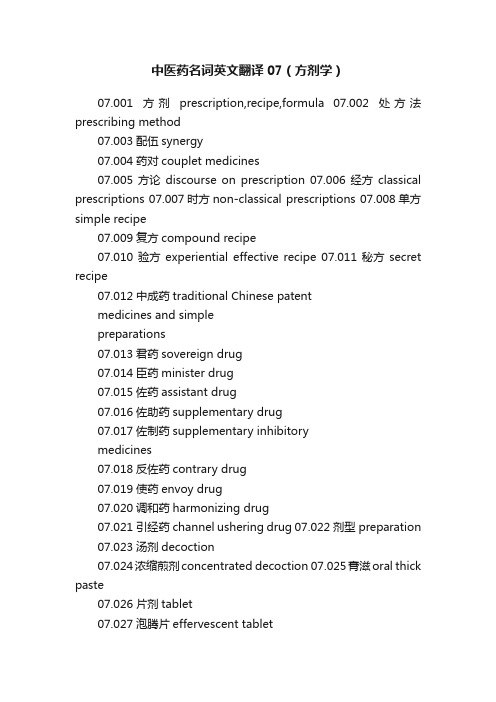
中医药名词英文翻译07(方剂学)07.001方剂prescription,recipe,formula 07.002处方法prescribing method07.003配伍synergy07.004药对couplet medicines07.005方论discourse on prescription 07.006经方classical prescriptions 07.007时方non-classical prescriptions 07.008单方simple recipe07.009复方compound recipe07.010验方experiential effective recipe 07.011秘方secret recipe07.012中成药traditional Chinese patentmedicines and simplepreparations07.013君药sovereign drug07.014臣药minister drug07.015佐药assistant drug07.016佐助药supplementary drug07.017佐制药supplementary inhibitorymedicines07.018反佐药contrary drug07.019使药envoy drug07.020调和药harmonizing drug07.021引经药channel ushering drug 07.022剂型preparation07.023汤剂decoction07.024浓缩煎剂concentrated decoction 07.025膏滋oral thick paste07.026片剂tablet07.027泡腾片effervescent tablet07.028线剂thread formula07.029条剂stripe formula07.030露剂distillate formula07.031膏药plaster;medicinal paste 07.032软膏剂ointment07.033散剂powder07.034丸剂pill, bolus07.035蜜丸honeyed pill07.036水丸watered pill07.037水蜜丸water-honeyed pill 07.038糊丸flour and water paste pill 07.039浓缩丸concentrated pill07.040蜡丸wax pill07.041微丸mini-pill07.042滴丸剂dripping pill07.043颗粒剂granules07.044胶囊剂capsule07.045硬胶囊剂hard capsule07.046软胶囊剂soft capsule07.047微囊剂micro-capsule07.048茶剂medicinal tea07.049糕剂cake07.050栓剂suppository07.051搽剂liniment07.052锭剂lozenge07.053[烟]熏剂smoke fumigant 07.054曲剂fermented medicine 07.055胶剂gel07.056气雾剂aerosol07.057喷雾剂spray07.058灌肠剂enema07.059灸剂moxibustion formula 07.060熨剂compression formula 07.061合剂mixture07.062酊剂tincture07.063酒剂wine07.064浸膏剂extract07.065流浸膏剂liquid extract07.066口服液oral liquid07.067糖浆剂syrup07.068注射剂injection07.069乳剂emulsion07.070滴鼻剂nasal drop07.071滴眼剂eye drop07.072滴耳剂ear drop07.073水煎decoct with water 07.074酒煎decoct with wine 07.075先煎decocted earlier 07.076后下decocted later07.077包煎wrap-boiling07.078另煎decocted separately07.079烊化melt07.080兑入mix07.081生汁兑入mix with fresh juice07.082溶化dissolve07.083冲服administered after dissolved 07.084火候optimal fire07.085文火mild fire07.086武火strong fire07.087临睡服administered before bed time 07.088饭前服administered before meal; a.c.;ante cibum07.089饭后服administered after meal ; p.c.;post cibum07.090空腹服administered at empty stomach 07.091热服administered hot07.092温服administered warm07.093冷服administered cold07.094噙化administered under tongue 07.095顿服administered at draught07.096分服taken separately07.097频服taken frequently07.098药引medicinal usher07.099解表剂superficies-resolving formula 07.100辛温解表剂formula for relieving superficiessyndrome with pungent andwarm natured drugs07.101辛凉解表剂formula for relieving superficiessyndrome with pungent and coolnatrued drugs07.102扶正解表剂formula for strengthening bodyresistance and relievingsuperficies07.103表里双解剂formula for relieving bothsuperficial and internal disorders 07.104解表清里剂formula for relieving superficiesand clearing interior07.105解表温里剂formula for relieving superficiesand warming interior07.106解表通里剂formula for relieving superficiesand catharsis07.107和解少阳剂reconciling shaoyang formula 07.108清热剂heat-clearing formula07.109清气分热剂formula for clearing heat at qilevel07.110清营凉血剂formula for clearing nutrient leveland cooling blood07.111清热解毒剂formula for clearing heat andremoving toxicity07.112清脏腑热剂formula for clearing heat inviscerae07.113清热解暑剂formula for clearing heat andanti-summer- heat07.114清虚热剂formula for clearing asthenicfever07.115温里剂warming interior formula07.116温中散寒剂formula for warming interior fordispersing cold07.117回阳救逆剂formula for restoring yang andrescuing patient from collapse 07.118温经散寒剂formula for warming channel fordispersing cold07.119泻下剂formula for purgation07.120寒下剂cold cathartic formula07.121温下剂warm cathartic formula07.122润下剂moistened cathartic formula 07.123逐水剂drastic diuretics formula07.124补益剂supplementing [and boosting]formula07.125补气剂qi-supplementing formula07.126补血剂blood-supplementing formula07.127气血双补剂formula for benefiting both qi andblood07.128补阴剂yin-supplementing formula07.129补阳剂yang-supplementing formula 07.130阴阳并补剂formula for benefiting both yinand yang07.131固涩剂astringent formula07.132固表止汗剂formula for consolidatingsuperficies for arresting sweating 07.133敛肺止咳剂formula for astringing lung forrelieving cough07.134涩肠固脱剂formula for astringing intestineand arresting proptosis07.135涩精止遗剂formula for astringingspermatorrhea07.136固崩止带剂formula for arresting leucorrheaand metrorrhagia07.137安神剂sedative;tranquillizing formula 07.138消食剂digestive formula07.139开窍剂formula for resuscitation07.140凉开剂cold formula for resuscitation 07.141温开剂warm formula for resuscitation 07.142理气剂carminative formula;qi regulatedformula07.143行气剂formula for activating qi flowing 07.144降气剂formula for descending qi07.145理血剂blood-regulating formula07.146活血剂blood-activating formula07.147止血剂blood-stanching formula07.148治风剂formula for wind disorder07.149疏散外风剂formula for dispersing externalwind07.150平熄内风剂formula for calming downinternal wind07.151祛湿剂desiccating formula07.152和胃燥湿剂formula for harmonizing thestomach and drying dampness 07.153清热祛湿剂formula for clearing heat andeliminating dampness07.154利水渗湿剂formula for diuresis and diffusingdampness07.155温化水湿剂formula for warmly resolvingwatery dampness07.156祛痰剂phlegm-expelling formula07.157温燥化痰剂formula for resolving phlegmwith warm drugs07.158清润化痰剂formula for resolving phlegmwith clear-moistening drugs 07.159治风化痰剂formula for resolving phlegmwith arresting wind07.160驱虫剂anti-helminthic formula07.161涌吐剂emetic formula07.162一贯煎yiguan decoction07.163丁香柿蒂汤dingxiang shidi decoction07.164七宝美髯丹qibao meiran mini-pills07.165七厘散qili powder;qili san07.166九仙散jiuxian powder07.167九味羌活汤jiuwei qianghuo decoction07.168二至丸erzhi pills07.169二妙散ermiao powder07.170二陈汤erchen decoction07.171八正散bazheng powder07.172八珍汤bazhen decoction07.173十灰散shihui powder07.174十枣汤shizao decoction07.175三子养亲汤sanzi yangqin decoction 07.176三甲复脉汤sanjia fumai decoction 07.177三仁汤sanren decoction07.178三物备急丸sanwu beiji pill07.179川芎茶调散chuanxiong chatiao powder;chuanxiong chatiao san07.180大补阴丸da buyin pill;da buyin wan 07.181大定风珠dadingfengzhu pill07.182大建中汤dajianzhong decoction07.183大承气汤dachengqi decoction07.184大柴胡汤dachaihu decoction07.185大秦艽汤daqinjiao decoction07.186大黄牡丹汤dahuang mudan decoction 07.187大黄附子汤dahuang fuzi decoction 07.188小建中汤xiaojianzhong decoction 07.189小金丹xiaojin mini-pills07.190小青龙汤xiaoqinglong decoction 07.191小活络丹xiaohuoluo mini-pills 07.192小柴胡汤xiaochaihu decoction 07.193小续命汤xiaoxuming decoction 07.194小蓟饮子xiaoji drink07.195小儿回春丹xiao'er huichun mini-pills 07.196乌梅丸wumei pills07.197五仁丸wuren pills07.198五皮饮wupi drink07.199五味消毒饮wuwei xiaodu drink07.200五苓散wuling powder;wuling san 07.201五积散wuji powder07.202六一散liuyi powder; liuyi san07.203六味地黄丸liuwei dihuang pill;liuweidihuang wan07.204内补黄芪汤neibu huangqi decoction07.205化虫丸huachong pill07.206升麻葛根汤shengma gegen decoction 07.207天王补心丹tianwang buxin mini-pills07.208天台乌药散tiantai wuyao powder07.209天麻钩藤饮tianma gouteng drink07.210木香槟榔丸muxiang binlang pills;muxiangbinlang wan07.211止痉散zhijing powder07.212止嗽散zhisou powder07.213贝母瓜蒌散beimu gualou powder07.214苇茎汤weijing decoction07.215仙方活命饮xianfang huoming drink07.216加减葳蕤汤jiajian weirui decoctionbanxia baizhu tianma decoction 07.217半夏白术天麻汤07.218半夏泻心汤banxia xiexin decoction07.219半夏厚朴汤banxia houpu decoction07.220右归丸yougui pill07.221右归饮yougui drink07.222四君子汤sijunzi decoction07.223四妙勇安汤simiao yong'an decoction 07.224四物汤siwu decoction07.225四神丸sishen pill;sishen wan 07.226四逆汤sini decoction;sini tang 07.227四逆散sini powder07.228失笑散shixiao powder07.229左归丸zuogui pill07.230左归饮zuogui drink07.231左金丸zuojin pill;zuojin wan07.232布袋丸budai pill07.233平胃散pingwei powder07.234归脾汤guipi decoction07.235玉女煎yunü decoction07.236玉屏风散yupingfeng powder07.237玉真散yuzhen powder;yuzhen san 07.238瓜蒂散guadi powder07.239甘麦大枣汤ganmai dazao decoction 07.240甘露消毒丹ganlu xiaodu micropills07.241生化汤shenghua decoction07.242生脉散shengmai powder; shengmaisan07.243白头翁汤baitouweng decoction07.244白虎汤baihu decoction07.245石斛夜光丸shihu yeguang pills;shihuyeguang wan07.246龙胆泻肝汤longdan xiegan decoction 07.247再造散zaizao powder;zaizao san 07.248地黄饮子dihuang drink07.249安宫牛黄丸angong niuhuang pills;angongniuhuang wan07.250导赤散daochi powder07.251当归六黄汤danggui liuhuang decoction 07.252当归四逆汤danggui sini decoction 07.253当归补血汤danggui buxue decoction 07.254朱砂安神丸zhusha anshen pills07.255百合固金汤baihe gujin decoction 07.256竹叶石膏汤zhuye shigao decoction 07.257至宝丹zhibao mini-pills07.258舟车丸zhouche pills07.259芍药汤shaoyao decoction07.260血府逐瘀汤xuefu zhuyu decoction 07.261防己黄芪汤fangji huangqi decoction07.262防风通圣散fangfeng tongsheng powder 07.263阳和汤yanghe decoction07.264吴茱萸汤wuzhuyu decoction07.265完带汤wandai decoction07.266杏苏散xingsu powder07.267牡蛎散muli powder07.268羌活胜湿汤qianghuo shengshi decoction 07.269苍耳散cang'er powder07.270苏子降气汤suzi jiangqi decoction07.271苏合香丸suhexiang pills;suhexiang wan07.272补中益气汤buzhongyiqi decoction07.273补阳还五汤buyang huanwu decoction 07.274补肺阿胶汤bufei ejiao decoction07.275连朴饮lianpu drink07.276麦门冬汤maimendong decoction07.277龟鹿二仙胶guilu erxian glue07.278参苏饮shensu drink07.279参附汤shenfu decoction。
中医中药英文翻译
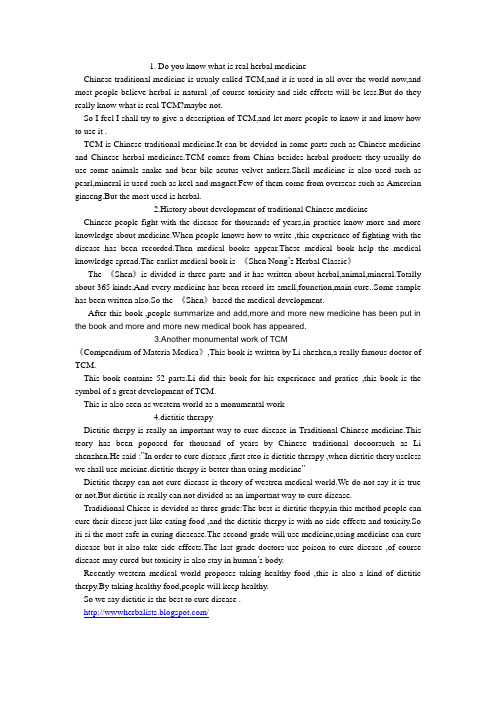
1. Do you know what is real herbal medicineChinese traditional medicine is usualy called TCM,and it is used in all over the world now,and most people believe herbal is natural ,of course toxicity and side effects will be less.But do they really know what is real TCM?maybe not.So I feel I shall try to give a description of TCM,and let more people to know it and know how to use it .TCM is Chinese traditional medicine.It can be devided in some parts such as Chinese medicine and Chinese herbal medicines.TCM comes from China besides herbal products they usually do use some animals snake and bear bile acutus velvet antlers.Shell medicine is also used such as pearl,mineral is used such as keel and magnet.Few of them come from overseas such as Amercian ginseng.But the most used is herbal.2.History about development of traditional Chinese medicineChinese people fight with the disease for thousands of years,in practice know more and more knowledge about medicine.When people knows how to write ,this experience of fighting with the disease has been recorded.Then medical books appear.These medical book help the medical knowledge spread.The earlist medical book is 《Shen Nong’s Herbal Classic》The 《Shen》is divided is three parts and it has written about herbal,animal,mineral.Totally about 365 kinds.And every medicine has been record its smell,founction,main cure..Some sample has been written also.So the 《Shen》based the medical development.After this book ,people summarize and add,more and more new medicine has been put in the book and more and more new medical book has appeared.3.Another monumental work of TCM《Compendium of Materia Medica》,This book is written by Li shezhen,a really famous doctor of TCM.This book contains 52 parts.Li did this book for his experience and pratice ,this book is the symbol of a great development of TCM.This is also seen as western world as a monumental work4.dietitic therapyDietitic therpy is really an important way to cure disease in Traditional Chinese medicine.This teory has been poposed for thousand of years by Chinese traditional docoorsuch as Li shenzhen.He said :”In order to cure disease ,first steo is dietitic therapy ,when dietitic thery useless we shall use meicine.dietitic therpy is better than using medicine”Dietitic therpy can not cure disease is theory of westren medical world.We do not say it is true or not.But dietitic is really can not divided as an important way to cure disease.Tradidional Chiese is devided as three grade:The best is dietitic thepy,in this method people can cure their disese just like eating food ,and the dietitic therpy is with no side-effects and toxicity.So iti si the most safe in curing diesease.The second grade will use medicine,using medicine can cure disease but it also take side effects.The last grade doctors use poison to cure disease ,of course disease may cured but toxicity is also stay in human’s body.Recently western medical world proposes taking healthy food ,this is also a kind of dietitic therpy.By taking healthy food,people will keep healthy.So we say dietitic is the best to cure disease ./。
中医药名词英文翻译01(学科相关词汇)
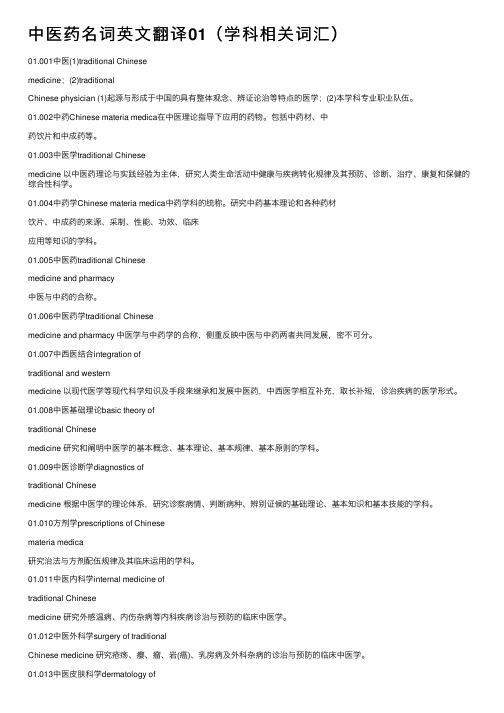
中医药名词英⽂翻译01(学科相关词汇)01.001中医(1)traditional Chinesemedicine;(2)traditionalChinese physician (1)起源与形成于中国的具有整体观念、辨证论治等特点的医学;(2)本学科专业职业队伍。
01.002中药Chinese materia medica在中医理论指导下应⽤的药物。
包括中药材、中药饮⽚和中成药等。
01.003中医学traditional Chinesemedicine 以中医药理论与实践经验为主体,研究⼈类⽣命活动中健康与疾病转化规律及其预防、诊断、治疗、康复和保健的综合性科学。
01.004中药学Chinese materia medica中药学科的统称。
研究中药基本理论和各种药材饮⽚、中成药的来源、采制、性能、功效、临床应⽤等知识的学科。
01.005中医药traditional Chinesemedicine and pharmacy中医与中药的合称。
01.006中医药学traditional Chinesemedicine and pharmacy 中医学与中药学的合称,侧重反映中医与中药两者共同发展,密不可分。
01.007中西医结合integration oftraditional and westernmedicine 以现代医学等现代科学知识及⼿段来继承和发展中医药,中西医学相互补充,取长补短,诊治疾病的医学形式。
01.008中医基础理论basic theory oftraditional Chinesemedicine 研究和阐明中医学的基本概念、基本理论、基本规律、基本原则的学科。
01.009中医诊断学diagnostics oftraditional Chinesemedicine 根据中医学的理论体系,研究诊察病情、判断病种、辨别证候的基础理论、基本知识和基本技能的学科。
01.010⽅剂学prescriptions of Chinesemateria medica研究治法与⽅剂配伍规律及其临床运⽤的学科。
中医英语课后句子翻译1(含中文 lesson1-10)
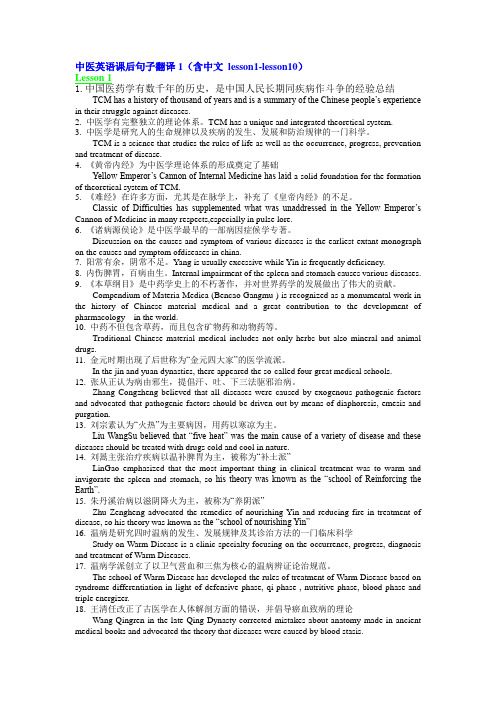
中医英语课后句子翻译1(含中文lesson1-lesson10)Lesson 11.中国医药学有数千年的历史,是中国人民长期同疾病作斗争的经验总结TCM has a history of thousand of years and is a summary of the Chinese people’s experience in their struggle against diseases.2. 中医学有完整独立的理论体系。
TCM has a unique and integrated theoretical system.3. 中医学是研究人的生命规律以及疾病的发生、发展和防治规律的一门科学。
TCM is a science that studies the rules of life as well as the occurrence, progress, prevention and treatment of disease.4. 《黄帝内经》为中医学理论体系的形成奠定了基础Yellow Emperor’s Cannon of Internal Medicine has laid a solid foundation for the formation of theoretical system of TCM.5. 《难经》在许多方面,尤其是在脉学上,补充了《皇帝内经》的不足。
Classic of Difficulties has supplemented what was unaddressed in the Yellow Emperor’s Cannon of Medicine in many respects,especially in pulse lore.6. 《诸病源侯论》是中医学最早的一部病因症候学专著。
Discussion on the causes and symptom of various diseases is the earliest extant monograph on the causes and symptom ofdiseases in china.7. 阳常有余,阴常不足。
点读机学习英文中医药名词英语翻译(方剂学英语词)点读机学习英文-真人朗读学习英语功能)

第 1 页,共 10 页
36、 37、 38、 39、 40、 41、 42、 43、 44、 45、 46、 47、 48、 49、 50、 51、 52、 53、 54、 55、 56、 57、 58、 59、 60、 61、 62、 63、 64、 65、 66、 67、 68、 69、 70、 71、 72、 73、 74、 75、 76、 77、 78、 79、
watered pill water-honeyed pill flour and water paste pill concentrated pill wax pill mini-pill dripping pill granules capsule hard capsule soft capsule micro-capsule medicinal tea cake suppository liniment lozenge smoke fumigant fermented medicine gel aerosol spray enema moxibustion formula compression formula mixture tincture wine extract liquid extract oral liquid syrup injection emulsion nasal drop eye drop ear drop decoct with water decoct with wine decocted earlier decocted later wrap-boiling decocted separately melt
南非荷兰语 捷克语
方剂 处方法 配伍 药对 方论 经方 时方 单方 复方 验方
秘方 中成药 君药 臣药 佐药 佐助药 佐制药 反佐药 使药 调和药 引经药 剂型 汤剂 浓缩煎剂 膏滋 片剂 泡腾片 线剂 条剂 露剂 膏药 软膏剂 散剂 丸剂 蜜丸
日语翻译常用词汇(七)中医药部分
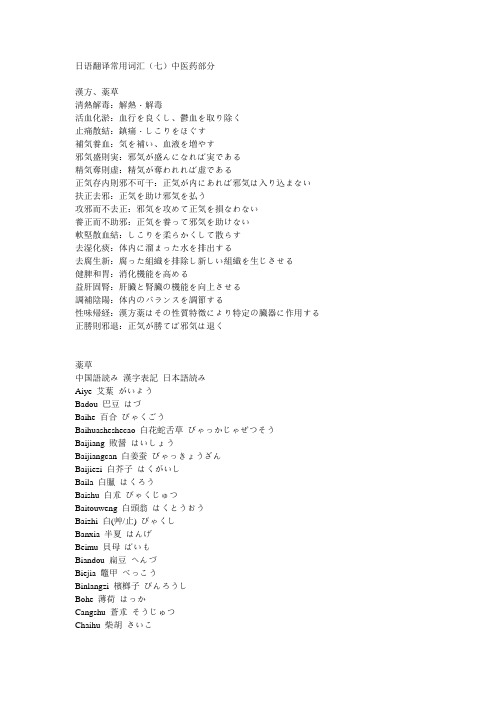
日语翻译常用词汇(七)中医药部分漢方、薬草清熱解毒:解熱・解毒活血化淤:血行を良くし、鬱血を取り除く止痛散結:鎮痛・しこりをほぐす補気養血:気を補い、血液を増やす邪気盛則実:邪気が盛んになれば実である精気奪則虚:精気が奪われれば虚である正気存内則邪不可干:正気が内にあれば邪気は入り込まない扶正去邪:正気を助け邪気を払う攻邪而不去正:邪気を攻めて正気を損なわない養正而不助邪:正気を養って邪気を助けない軟堅散血結:しこりを柔らかくして散らす去湿化痰:体内に溜まった水を排出する去腐生新:腐った組織を排除し新しい組織を生じさせる健脾和胃:消化機能を高める益肝固腎:肝臓と腎臓の機能を向上させる調補陰陽:体内のバランスを調節する性味帰経:漢方薬はその性質特徴により特定の臓器に作用する正勝則邪退:正気が勝てば邪気は退く薬草中国語読み漢字表記日本語読みAiye 艾葉がいようBadou 巴豆はづBaihe 百合びゃくごうBaihuasheshecao 白花蛇舌草びゃっかじゃぜつそうBaijiang 敗醤はいしょうBaijiangcan 白姜蚕びゃっきょうざんBaijiezi 白芥子はくがいしBaila 白臘はくろうBaishu 白朮びゃくじゅつBaitouweng 白頭翁はくとうおうBaizhi 白(艸/止) びゃくしBanxia 半夏はんげBeimu 貝母ばいもBiandou 扁豆へんづBiejia 鼈甲べっこうBinlangzi 檳榔子びんろうしBohe 薄荷はっかCangshu 蒼朮そうじゅつChaihu 柴胡さいこChansu 蟾蘇せんそChantui 蝉退せんたいChenpi 陳皮ちんぴChensha 辰砂しんしゃChenxiang 沈香ぢんこうCheqianzi 車前子しゃぜんしChishizhgi 赤石脂しゃくせきしChixiaodou 赤小豆しゃくしょうづChuangong 川(艸弓)せんきゅうChuanlianzi 川棟子せんれんしCongbai 葱白そうはくDafupi 大腹皮だいふくひDahuang 大黄だいおうDanfan 胆礬たんばんDanggui 当帰とうきDasheshi 大赭石だいしゃせきDazao 大棗だいそうDengxincao 燈心草とうしんそうDiaotenggou 釣藤鈎ちょうとうこうDigupi 地骨皮ぢこっぴDihuang 地黄ぢおうDingxiang 丁香ちょうこうDuhuo 独活どっかつDuzhong 杜仲とちゅうEjiao 阿膠あきょうFanbi 反鼻はんびFangfeng 防風ぼうふうFangyi 防已ぼういFeizi 榧子ひしFengmi 蜂蜜ほうみつFuling 茯苓ぶくりょうFulonggan 伏龍肝ぶくりゅうかんFuzi 附子ぶしGancao 甘草かんぞうGandihuang 甘地黄かんぢおうGanjiang 乾姜かんきょうGegen 葛根かっこんGengmi 粳米こうべいGuadi 瓜蔕かていGualvgen 瓜呂根かろうこんGualvshi 瓜呂実かろうじつGuazi 瓜子かしGuiban 亀板きばんGuizhi 桂枝けいしHairencao 海人草かいにんそうHaoben 蒿本こうほんHeshouwu 何首烏かしゅうHonghua 紅花こうかHoupu 厚朴こうぼくHuangbai 黄柏おうばくHuangcen 黄岑おうごんHuanglian 黄連おうれんHuangshi 黄蓍おうぎHuangtu 黄土おうどHuashi 滑石かっせきHuhuanglian 胡黄連こおうれんHuixiang 茴香ういきょうHuma 胡麻ごまHuoxiang (艸/霍)香かっこうJilizi (艸疾)梨子しつりしJiaoyi 膠飴こういJiezi 芥子かいしJingjie 荊芥けいがいJinxie 津蟹しんかいJinyinhua 金銀花きんぎんかJuemingzi 決明子けつめいしJugeng 桔梗ききょうJuhua 菊花きくかJupi 橘皮きっぴKushen 苦参くじんLiangjiang 良姜りょうきょうLianqiao 連翹れんぎょうLianrou 蓮肉れんにくLigenpi 李根皮りこんぴLingyangjiao 羚羊角れいようかくLiuhuang 硫黄いおうLomggu 龍骨りゅうこつLongdan 竜胆りゅうたんLongyanrou龍眼肉りゅがんにくLuanfashuang 乱髪霜らんはつそうLufengfang 露蜂房ろほうぼうLujiao 鹿角ろっかくLvfan 緑礬りょくばんMahuang 麻黄まおうMaimendong 麦門冬ばくもんどうMaiya 麦芽ばくがMamingtui 馬明退ばめいたいMangchong 虻虫ぼうちゅうMangxiao 芒硝ぼうしょうManxingzi 蔓荊子まんけいしMaziren 麻子仁ましにんMila 蜜蝋みつろうMudanpi 牡丹皮ぼたんぴMugua 木瓜もくかMuli 牡蠣ぼれいMutong 木通もくつうMuxiang 木香もっこうNiufangzi 牛房子ごぼうしNiuhuang 牛黄ごおうNiuxi 牛膝ごしつNvzhenzi 女貞子じょていしPipaye 枇杷葉びわようPohuzhi 破胡紙はこしPugongying 蒲公英ほこうえいPushu 樸束ぼくそくQianbai 鉛白えんぱくQianghuo 羌活きょうかつQianhu 前胡ぜんこQianniuzi 牽牛子けんごしQingfen 軽粉けいふんQingpi 青皮しょうひRendong 忍冬にんどうRenshen 人参にんじんSangbaipi 桑白皮そうはくひShandougen 山豆根さんづこんShanguilai 山帰来さんきらいShanyao 山薬さんやくShanzhazi 山査子さんざしShanzhuyu 山茱萸さんしゅゆShaoyao 芍薬しゃくやくShechuangzi 蛇床子じゃじょうしShegucai 鷓胡菜しゃこさいShengjiang 生姜しょうきょうShengma 升麻しょうまShenqu 神麹しんきくShexiang 麝香じゃこうShidi 柿蔕していShigao 石膏せっこうShijiao 石(角斗)せっこくShijueming 石決明せっけつめいShu 朮じゅつShudihuang 熟地黄じゅくぢおうShuizhi 水蛭すいしつShujiao 蜀椒しゅくしょうShuyu 薯預じょよSongzhi 松脂しょうしSuanzaoren 酸棗仁さんそうにんSuosha 縮砂しゅくしゃSuye 蘇葉そようSuzi 蘇子そしTaoren 桃仁とうにんTianhuafen 天花粉てんかふんTianma 天麻てんまTianmendong 天門冬てんもんどうTiannanxing 天南星てんなんしょうTufuling 土茯苓どぶくりょうTunzhi 豚脂とんしWeilingxian 威霊仙いれいせんWoshu 莪朮がじゅつWumei 烏梅うばいWutou 烏頭うづ(附子)Wuweizi 五味子ごみしWuyao 烏薬うやくWuzhuyu 呉茱萸ごしゅゆXiakucao 夏枯草かごそうXiangfuzi 香附子こうぶしXiaomai 小麦しょうばくXiaoshi 消石しょうせきXijiao 犀角さいかくXingren 杏仁きょうにんXinyi 辛夷しんいXiogndan 熊胆ゆうたんXixin 細辛さいしんXuanfuhua 旋覆花せんぷくかXuanshen 玄参げんじんYangmeipi 楊梅皮ようばいひYanhusuo 延胡索えんごさくYanshu 鼬鼠えんそYinchen 茵陳いんちんYingpi 桜皮おうひYiyiren 翌苡仁よくいにんYuanzhi 遠志えんじYujin 宇金うこんYuxingcao 魚腥草ぎょせいそうZaojiaoci 皀角刺そうかくしZexie 沢瀉たくしゃZhensha 鍼砂しんしゃZhimu 知母ちもZhiqiao 枳殻きこくZhishi 枳実きじつZhizi 梔子ししZhujierenshen 竹節人参ちくせつにんじんZhuling 猪苓ちょれいZhuru 竹茹ちくじょZhuye 竹葉ちくようZigen 紫根しこんZisu 紫蘇しそZonglvye 棕梠葉しゅろよう薬用植物日本語→中国語アーモンド,扁桃アオダモ,白臘樹アカメガシワ,野悟桐アシタバ,明日叶アスパラサスリネアリス,抗酸茶アセンヤク,児藥アボガド,牛油果アマチャ,甘茶アマチャヅル,絞股藍アラビアチャノキ,阿拉伯茶樹アラビアモツヤク,没藥樹アルテア,蜀葵アルニカ,山金車花アロエ,芦薈アンズ,杏子アンソッコウ,安息香イチイ,一位叶擒イチゴ,草莓イチョウ,白果イヌサフラン,秋水仙イラクサ,蕁草イリス,菖蒲イレイセン,威靈仙インチンコウ,茵陳蒿インドジャボク属,印度蛇木インドボダイジュ,菩提樹インヨウカク,淫羊(艸/霍)ウイキョウ,小茴香ウーロンチャ,烏龍茶ウコン,姜黄ウマノスズクサ属,馬兜鈴ウメ,烏梅ウヤク,烏藥ウワウルシ,熊果エイジツ,營實エゴマ,紫蘇梗エゾウコギ,刺五加エチナシ,狭叶紫錐花エニシダ,花竹柏エンゴサク,延胡索エンジュ,(木鬼)位エンジュ,(木鬼)花オウカシ,櫟樹,(木角斗)樹オウカボ,金午時花オウギ,黄耆オウゴン,黄岑オウバク,黄柏オウヒ,桜皮オウレン,黄連オオバナサルスベリ,紫薇オオムギ,大麦オクラ,秋葵オシダ,粗茎鱗毛蕨オトギリソウ,小連翹連オドリコソウ,光柄野芝麻オノニス,刺芒柄花オノニス,針苜蓿オモト,万年青オランダカラシ,水芥子オレンジ,橙オンジ,遠志カイソウ,褐藻カイソウ〈海葱〉属,海葱カイトウヒ,海棹皮ガイヨウ,艾叶カガミグサ,白斂カゴソウ,夏枯草カシ,訶子カシュウ,何首烏ガジュツ,莪術カスカラサグラダ,鼠李カッコウ,(艸/霍)香カッコン,葛根カノコソウ,纈草根カバ根,(上/卜)瓦(上/卜)瓦カミツレ,黄花菊カミツレ,羅馬甘菊カラスムギ,燕麦カラバル豆,(上/卜)拉瓦豆カリン花,(木門<呂),花梨カロコン,瓜呂根カロライナジャスミン,素馨カワラタケ,云芝菌カンショウコウ,甘蔗カンゾウ,甘草カントウカ,款冬花カンボウイ,漢防已カンラン,(木敢)欒キイチゴ,樹莓キウイ,(狂弥-王)猴桃キキョウ,桔梗キササゲ,梓實キジツ,枳實キッピ,橘皮キナ,金鷄納樹皮キュウリ,胡瓜キョウカツ,(羊/元-二)活キョウニン,苦杏仁キンリュウカ,羊角藤クインスシド,木瓜子ククイナッツ,木立芦薈油クジン,苦参クスノハガシワ,粗糠柴クマザサ,山白竹クミン,小茴香クルミ,核桃楸グレープフルーツ,葡萄柚クレマチス,鉄線蓮クロレラ,緑藻ケイガイ,荊芥穂ケイケットウ,白花油麻藤ケイヒ,月桂,肉桂ケシ,罌粟ケツメイシ,决明子ケンゴシ,牽牛子ゲンジン,玄参ゲンチアナ,龍胆草ゲンノショウコ,天竺葵ケンポナシ,枳具,拐棗コウカ,紅花コウジン,紅参コウチャ,茶コウブシ,香附子コウボ,酵母コウボク,厚朴コウ木ン,藁本ゴオウ,牛黄コオウレン,胡黄連コーヒーノキ,(ロ加)(ロ非)ゴールデンシル,白毛(艸/艮)コケモモヨウ,山桑子ゴシツ,牛膝ゴシュユ,呉茱萸コジョウコン,虎杖根コパイーバ,苦配巴ゴバイシ,五倍子コハク,琥珀ゴボウシ,牛蒡子ゴマ,芝麻ゴミシ,五味子コムギ,小麦コメ,大米コメ,大米コロシントウリ,古魯聖篤實柴胡コンフリー,聚合草サイコ,圓柏サイシン,細辛サトウキビ,甘蔗サビナ,鎖陽サフラン,番紅花サボンソウ,石鹸草サヨウ,飛龍掌血サルカケミカン,洋(艸/拔)契サワギキョウ,无柄叶山梗菜サンキライ,土茯苓サンザシ,野山(木査)サンシシ,(木ノ/厄)子サンシュユ,山茱萸サンショウ,蜀椒サンショウコン,酸漿根サンズコン,山豆根サンヤク,山藥ジオウ,地黄シオン,紫苑ジギタリス,洋地黄叶シキミ,巽草携ジコッピ,地骨皮シコン,紫草シタケ,香蕈シツリシ,(シ分)梨子シテイ,柿蒂シナノキ,日本紫椴シモツケソウ,密叶蚊子草シャクゼンシ,車前子シャクゼンソウ,車前草シャクヤク,白芍、赤芍ジャショウシ,蛇床子ジュウヤク,魚腥草シュクシャ,砂仁ジュズダマ,回回米ショウキョウ,生姜ショウズク,小豆蒄ショウブコン,菖蒲根ショウボクヒ,樟木皮ショウマ,升麻ショウリク,商陸シラカバ,白樺シンイ,辛夷ジンコウ,(シ冗)香スイカズラ,忍冬藤スカルキャップ,黄岑スギナ,問荊スズラン,鈴蘭ステビア,甜菊スペアミント,留蘭香セイコウ,青蒿セイジ,艾草セイヨウキズタ,常春藤セイヨウサンザシヨウ,山櫨山査セイヨウトチノキ,七叶樹,婆羅子セイヨウニワトコ,接骨木セイヨウネズ,杜松セイヨウノコギリソウ,西洋蓍草セイヨウハッカ,薄荷セイヨウヤドリギ,(木角斗)寄生セキイ,石韋セキサン,石蒜セキショウコン,石菖蒲セキナンヨウ,石南叶セッコク,石斛ゼニアオイ,錦葵セネガ,遠志根セロリ,芹菜センキュウ,川(艸/弓)ゼンコ,前胡センコツ,萍蓬草センソ,蟾酥センソウ〈茜草〉,茜草・過山龍センダン,苦棟センナ,番潟叶センプクカ,旋覆花センブリ,日本(狂章-王)牙菜ソウカ,草果ソウシシ,相思子ソウジシ,蒼耳子ソウジュツ,蒼術ソウジュヨウ,列当、栗当ソウハクヒ,桑白皮ソウボク,惣木ゾクダン,續断ソテツ,蘇鉄實ソボク,蘇木ソヨウ,紫蘇叶(巾壽)擒ソリシ,鼠李子ダイオウ,大黄ダイケイ,薊ダイズ,香(豆支)タイソウ,大棗ダイフクヒ,大腹皮タイム,百里香タクシャ,澤潟ダミアナ,大迷亞納草タラコンピ,八角金盤タンジン,丹参チクジョ,竹茹チクセツニンジン,土参チモ,知母チユ,地楡チョウジ,丁香チョウセンアサガオ属,曼陀羅草チョウトウコウ,鈎藤チョレイ,猪苓チンピ,陳皮ツキミソウ,月見草ツバキ,山茶ツボクサ,雪草テウチグルミ,野核桃デューク,杜(サ/姑)テルミナリア,千果, 油欒仁テレビン,油松節油テンナンショウ,天南星テンマ,天麻テンモンドウ,天門冬トウガシ,冬瓜子トウガラシ,番椒トウキ,当帰トウキンセンカ,孔雀草,万寿菊トウジン,党参トウシンソウ,灯芯草トウチュウカソウ,冬虫夏草トウツルキンバイ,蔓越梅トウニン,桃仁トウヒ,橙皮トウリョウソウ,藤蓼ドクカツ,独活トコン属,吐根トシシ,菟絲子トショウ,杜松トチュウ,杜仲トマト,番茄ドモッコウ,土木香トラガント,黄蓍膠トリカブト,属附子ナンテンジツ,南天携ナンハンゲ,玉米ニガキ,苦棟樹・食莫ニクジュヨウ,草(艸/從)蓉ニチニチソウ,長春花ニュウコウ,乳香ニョテイ,女貞子ニンニク,大蒜バーシック,核仁バイケイソウ属,東云草ハイショウ,黄花敗醤草バイモ,貝母バクガ,麦芽ハクシジン,柏子仁ハクセンピ,白鮮皮ハクトウオウ,白頭翁バクモンドウ,麦冬ハゲキテン,巴戟天ハシリドコロ属,莨(艸/宕)根ハズ,巴豆パセリ,蕃芫(艸/妥)ハチミツ,蜂蜜ハッカ,薄荷パパイヤ,万寿果ハマナス,(王攵)瑰ハマボウフウ,北沙参ハマメリスヨウ,金縷梅バラ,薔薇パリエタリア,夏白菊ハンゲ,半夏ヒキオコシ,藍萼香茶菜ヒノキ,桧木ビフィズス,菌双(止支)杆菌ヒマシ,油蓖麻ヒマラヤヒラタケ,環柄斗(サ/姑)、環柄側耳ビャクシ,白(艸/止)ビャクジュツ,白術ビャクダン,白檀ビャクブ,百部ヒヨス属,天仙子, 莨(艸/宕)子、牙痛ビワヨウ,枇杷フクジュソウ,福寿草ブクシンボク,茯神フクボンシ,覆盆子ブクリョウ,茯苓フジコブ,紫藤瘤フタバアオイ,薄叶細辛ブッチャーブルーム,假叶樹ブドウ,葡萄ブナ,日本山毛(木挙)フラングラ,皮長叶凍緑プルーン,李子ヘチマ,絲瓜ベラドンナ属,顛茄根ボウイ,防己ボウコン,白茅根ホウセンカ,鳳仙花ホウビソウ,風尾草ボウフウ,防風ボダイジュ,椴樹ボタンピ,牡丹皮ホップ,(口卑)酒花ポドフィルム,曼陀羅草ボレイ,牡蛎マオウ,麻黄マクリ,海人草マシニン,火麻人マチン属,馬銭子マツ,松樹マリアアザミ,水飛薊マルバタバコ,大叶烟草マンケイシ,蔓荊子マンドラゴラ属,毒参茄、魔苹果ミゾカクシ,半辺蓮ミツモウカ,蜜蒙花ミミセンナ,番潟叶ムイラプアマ,南美勃起樹ムクロジ,木(変-又/木)子ムラヤコエンジー,无患子メナモミ,灯篭草、着簽草メリッサ,香蜂叶メリロート,黄苜蓿モウオオレン,馬偽黄連モクゾク,木賊モクツウ,木通モクベッシ,木(敝/魚)子モッコウ,木香モツヤク,没藥モモハ,桃叶モヤシ,豆芽ヤクチ,益知ヤクモソウ,(艸/充)蔚子ヤグルマギク,翠藍芙蓉ヤブタバコ,天名精ヤボランジ,大叶麦門冬ユーカリ,(木安)樹ユーグレナ,裸藻ユウタン,熊胆ユキノシタ,虎耳草ユキノハナ属,雪花蓮ユキワリソウ,報春花、西洋桜草ユズ,柚子ユリ,百合ヨウバイヒ,楊梅皮ヨクイニン,(艸/意)苡仁ヨヒンベ,育亨ライム,(艸/来)檬ライムギ,黒麦ラタニア,石(王攵)瑰ラベンダー,薫衣草ランソウ,蘭草ランモ,藍藻(王粲)リュウタン,龍胆リュウノウ,龍腦リョウキョウ,高良姜リンゴ,苹果レイシ,茘枝レタス,生菜レモン,檸檬レンギョウ,連翹レンゲソウ,翹揺ロウハクカ,狼把草ローズヒップ,野(王攵)瑰ローズマリー,迷迭香ロートコン,莨(艸/宕)根ローヤルゼリー,蜂王漿ロクテイソウ,鹿蹄草ロコン,芦根ロジン,松脂。
中医药名词英文翻译07(方剂学)

中医药名词英文翻译07(方剂学)07.001方剂prescription在辨证、辨病,确定立法的基础上,根据组方原则和结构,选择适宜药物组合而成的药方和制剂。
07.002处方法prescribing method根据大量方剂分类,总结出用药规律,以法统方,指导临床用药组方的方法。
07.003配伍synergy采取两种或两种以上中药组合成方,以增效减毒、提高疗效的中医主要用药形式。
07.004药对couplet medicines两味药成对相配,多有协同增效或减毒作用。
07.005方论discourse onprescription 对方剂的名称、药物的组成配伍、功效主治、用量服法及其加减等的论述。
07.006经方classical prescriptions汉代以前经典医药著作中记载的方剂,以张仲景的方剂为代表。
07.007时方non-classicalprescriptions 汉代张仲景之后医家所创制的方剂,与经方相对而言。
07.008单方simple recipe多为用单味药或简单的药味组成的方剂。
07.009复方compound recipe两味药物以上组成的方剂。
古称重方。
07.010验方experiential effectiverecipe临床反复使用而有效的方剂。
07.011秘方secret recipe有效而密不外传的方剂。
07.012中成药traditional Chinesepatent medicines andsimple preparations 临床反复使用、安全有效、剂型固定,并采取合理工艺制备成质量稳定、可控,经批准依法生产的成方中药制剂。
07.013君药sovereign drug又称"主药"。
方剂中对主证或主要症状起主要治疗作用的药物。
07.014臣药minister drug又称"辅药"。
方剂中辅助君药治疗主证的药物。
医学常用中医药名称英文翻译

医学常用中医药名称英文翻译Medical Translation of Commonly Used Traditional Chinese Medicine NamesIntroduction:Traditional Chinese Medicine (TCM) has a long history and rich cultural heritage. It relies on the use of various herbs and natural ingredients to treat diseases and promote wellness. Understanding the English translation of commonly used Chinese medicine names is essential for global communication and integration in the field of medicine. In this article, we will explore the English translations of frequently used TCM names.1. Herbal Medicine Names:1.1. Huang Qin (黄芩):- English Translation: Scutellariae Radix- Description: The root of Scutellaria baicalensis, commonly used to clear heat and resolve dampness.1.2. Dang Gui (当归):- English Translation: Angelicae Sinensis Radix- Description: The root of Angelica sinensis, known for its blood-tonifying and regulating properties.1.3. Bai Shao Yao (白芍药):- English Translation: Paeoniae Radix Alba- Description: The root of Paeonia lactiflora, often used to nourish blood and regulate menstruation.2. Mineral Medicine Names:2.1. Zhen Zhu (珍珠):- English Translation: Margarita- Description: Pearl, a mineral substance used in TCM for its calming and nourishing effects.2.2. Long Gu (龙骨):- English Translation: Fossilia Ossis Mastodi- Description: Fossilized bones of animals, such as mastodons, used to calm the mind and relieve convulsions.2.3. Hu Po (琥珀):- English Translation: Succinum- Description: Amber, a fossilized resin often used in TCM to invigorate blood circulation.3. Animal Medicine Names:3.1. Shu Di Huang (熟地黄):- English Translation: Rehmanniae Radix Preparation- Description: Prepared roots of Rehmannia glutinosa, commonly used for nourishing the blood and promoting vitality.3.2. Bai Ji (白芨):- English Translation: Bletillae Rhizoma- Description: The rhizome of Bletilla striata, used in TCM to stop bleeding and heal wounds.3.3. She Xiang (麝香):- English Translation: Moschus- Description: Musk, a secretion from the glandular sacs of male musk deer, often used for its pain-relieving and warming properties.Conclusion:Understanding the English translation of commonly used Chinese medicine names allows for effective communication and collaboration between TCM practitioners and the global medical community. This article provided the English translations of a few frequently used TCM names across different categories, including herbal, mineral, and animal medicines. It is important to note that accurate translation and comprehensive understanding of TCM names are crucial for proper usage and integration of TCM in modern healthcare practices.。
中医药名词英文翻译08(针灸学)
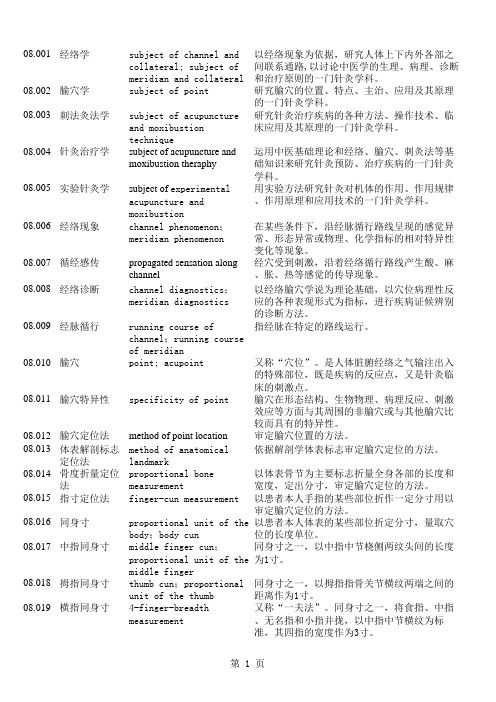
08.001经络学subject of channel andcollateral; subject ofmeridian and collateral 以经络现象为依据,研究人体上下内外各部之间联系通路,以讨论中医学的生理、病理、诊断和治疗原则的一门针灸学科。
08.002腧穴学subject of point研究腧穴的位置、特点、主治、应用及其原理的一门针灸学科。
08.003刺法灸法学subject of acupunctureand moxibustiontechnique 研究针灸治疗疾病的各种方法、操作技术、临床应用及其原理的一门针灸学科。
08.004针灸治疗学subject of acupuncture andmoxibustion theraphy 运用中医基础理论和经络、腧穴、刺灸法等基础知识来研究针灸预防、治疗疾病的一门针灸学科。
08.005实验针灸学subject of experimentalacupuncture andmoxibustion 用实验方法研究针灸对机体的作用、作用规律、作用原理和应用技术的一门针灸学科。
08.006经络现象channel phenomenon;meridian phenomenon 在某些条件下,沿经脉循行路线呈现的感觉异常、形态异常或物理、化学指标的相对特异性变化等现象。
08.007循经感传propagated sensation alongchannel 经穴受到刺激,沿着经络循行路线产生酸、麻、胀、热等感觉的传导现象。
08.008经络诊断channel diagnostics;meridian diagnostics 以经络腧穴学说为理论基础,以穴位病理性反应的各种表现形式为指标,进行疾病证候辨别的诊断方法。
08.009经脉循行running course ofchannel;running courseof meridian指经脉在特定的路线运行。
中医药主题英语作文带翻译

中医药主题英语作文带翻译Chinese Medicine。
Chinese medicine, also known as Traditional Chinese Medicine (TCM), is a unique and holistic approach to healthcare that has been practiced for thousands of years in China. It encompasses various forms of treatments, including acupuncture, herbal medicine, massage, and dietary therapy.Acupuncture, perhaps the most well-known aspect of Chinese medicine, involves the insertion of thin needles into specific points on the body. It is believed to stimulate the flow of energy, or Qi, along the body's meridians, and restore balance and harmony. Many people find acupuncture to be a highly effective treatment for a wide range of conditions, from pain relief to stress reduction.Herbal medicine is another integral part of Chinesemedicine. It involves the use of natural substances, suchas plants, minerals, and animal products, to treat and prevent illnesses. Chinese herbal formulas are carefully crafted to address each individual's unique symptoms and imbalances. The use of herbal medicine can be traced back thousands of years and continues to be a popular and effective treatment option in China and around the world.Massage, or Tui Na, is a form of Chinese therapeutic bodywork that involves various techniques, such as kneading, pressing, and stretching. It is used to promote the flow of Qi and blood, relieve muscle tension, and improve overall well-being. Tui Na is often combined with acupuncture for a more comprehensive treatment approach.Dietary therapy is an important aspect of Chinese medicine that emphasizes the importance of food as medicine. It involves the use of specific foods and cooking methodsto promote health and prevent disease. For example, certain foods are believed to have warming or cooling properties, and can be used to balance the body's energy. Dietary therapy is tailored to each individual's constitution andhealth condition.Chinese medicine is based on the concept of Yin and Yang, which represent opposite but complementary forces in the universe. It views health as a state of balance between these two forces, and illness as a result of their imbalance. Chinese medicine aims to restore this balance through various treatments and lifestyle adjustments.In recent years, Chinese medicine has gained recognition and popularity in the Western world. Many people are turning to Chinese medicine as a complementary or alternative approach to conventional medicine. Its holistic nature and focus on individualized care make it an appealing option for those seeking a more natural and personalized approach to healthcare.In conclusion, Chinese medicine offers a unique and comprehensive approach to healthcare that has stood thetest of time. Its various forms of treatments, such as acupuncture, herbal medicine, massage, and dietary therapy, provide a holistic and individualized approach to promotinghealth and well-being. Whether used as a standalone treatment or in combination with conventional medicine, Chinese medicine offers a valuable and effective approach to healthcare.。
中医英语常用语
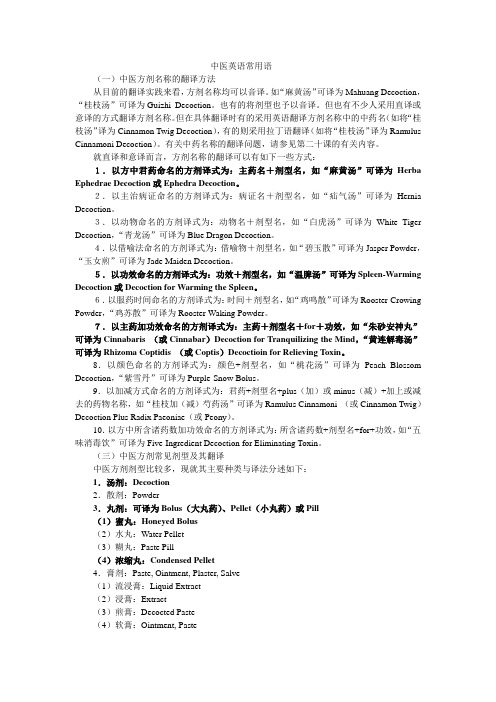
中医英语常用语(一)中医方剂名称的翻译方法从目前的翻译实践来看,方剂名称均可以音译。
如“麻黄汤”可译为Mahuang Decoction,“桂枝汤”可译为Guizhi Decoction。
也有的将剂型也予以音译。
但也有不少人采用直译或意译的方式翻译方剂名称。
但在具体翻译时有的采用英语翻译方剂名称中的中药名(如将“桂枝汤”译为Cinnamon Twig Decoction),有的则采用拉丁语翻译(如将“桂枝汤”译为Ramulus Cinnamoni Decoction)。
有关中药名称的翻译问题,请参见第二十课的有关内容。
就直译和意译而言,方剂名称的翻译可以有如下一些方式:1.以方中君药命名的方剂译式为:主药名+剂型名,如“麻黄汤”可译为Herba Ephedrae Decoction或Ephedra Decoction。
2.以主治病证命名的方剂译式为:病证名+剂型名,如“疝气汤”可译为Hernia Decoction。
3.以动物命名的方剂译式为:动物名+剂型名,如“白虎汤”可译为White Tiger Decoction,“青龙汤”可译为Blue Dragon Decoction。
4.以借喻法命名的方剂译式为:借喻物+剂型名,如“碧玉散”可译为Jasper Powder,“玉女煎”可译为Jade Maiden Decoction。
5.以功效命名的方剂译式为:功效+剂型名,如“温脾汤”可译为Spleen-Warming Decoction或Decoction for Warming the Spleen。
6.以服药时间命名的方剂译式为:时间+剂型名,如“鸡鸣散”可译为Rooster-Crowing Powder,“鸡苏散”可译为Rooster-Waking Powder。
7.以主药加功效命名的方剂译式为:主药+剂型名+for+功效,如“朱砂安神丸”可译为Cinnabaris (或Cinnabar)Decoction for Tranquilizing the Mind,“黄连解毒汤”可译为Rhizoma Coptidis (或Coptis)Decoctioin for Relieving Toxin。
- 1、下载文档前请自行甄别文档内容的完整性,平台不提供额外的编辑、内容补充、找答案等附加服务。
- 2、"仅部分预览"的文档,不可在线预览部分如存在完整性等问题,可反馈申请退款(可完整预览的文档不适用该条件!)。
- 3、如文档侵犯您的权益,请联系客服反馈,我们会尽快为您处理(人工客服工作时间:9:00-18:30)。
结
语
TCM with its unique diagnostic methods, systematic approach, abundant historical literature and materials, has attached many attentions from the international community. 中医以其独特的诊断手法、系统的治疗方式和丰富的典籍 材料,备受世界瞩目。 TCM is an integral part of Chinese culture. It has made great contributions to the prosperity of China. 中医是华夏文化不可分割的一部分,为振 兴中华做出了巨大的贡献。
The Terminology of TCM
• 药名翻译: 王不留行:SEMEM VACCARIAE
石竹科植物麦蓝菜的干燥成熟种子。功效活血通经, 下乳消肿。用于乳汁不下,乳房肿痛。孕妇慎用。 The dried ripe seed of Vaccaria segetalis (Neck.) Garcke. Indications: mastitis with swelling and pain of the breast. It should be used very cautiously for pregnant women.
《本草纲目》 Compendium of Materia Medica
明 李时珍撰。刊于1590年,52卷。共 收药1892种,附方1万余首,插图1千余幅。 此书全面系统总结了明代以前的药物学成 就,考证了很多过去本草学中的错误,提出 了较科学的药物学分类方法,具有很高的实 用价值,在国内外有很大影响,并译成多国 文字。
Inspection
• Inspection is the first diagnostic procedure by which the physician may observe the patient's vitality, complexion, physical build, head, neck, five sense organs, skin, tongue, external genitalia and anus on purpose so as to understand the condition of a disease. TCM holds that the human body is an organic whole. The exterior of the body is closely related to the internal organs. • 望诊是诊断的首 要程序,通过望诊, 医生可以有目的的 观察病人的神、色、 体质、头、颈、五 官、皮肤、舌头、 前后二阴,以了解 疾病的状况。中医 认为人体是一个有 机整体,体表和内 脏是紧密联系的。
常见中药翻译
• 人参:Radix Ginseng • 三七:Radix Notoginseng • 牛黄:Calculus Bovis • 玉竹:Rhizoma Polygonati Odorati • 白术:Rhizoma Atractylodis Macrocephalae
• 党参:Radix Codonopsis Pilosulae • 黄精:Rhizoma Polygonati • 鹿茸:Cornu Cervi Pantotrichum • 板蓝根:Radix Isatidis • 决明子: Semem Cassiae • 益母草:Herba Leonuri • 淫羊藿: Herba Epimedii
行医术语
• • • • 气化不利 dysfunction of qi in transformation 畏寒喜热 aversion to cold and preference for heat 清肺润燥 clearing the lung and moistening dryness 宁心安神 calming the heart and tranquilizing the mind • 血液亏虚 deficiency of the blood • 风为百病之长 feng is the leading factor in causing various diseases • 七情内伤 internal injury due to emotional disorder
Auscultation and Olfaction
• Auscultation means listening to the patient's voice, speaking, respiration, coughing and moaning. By auscultation, the doctor can not only learn about the changes of the phonatory organ, but also infer the pathological changes of the internal organs. • While olfaction means smelling the patient's odor of the secretion and excretion.
Pulse-taking and Palpation
• It is the fourth diagnostic methnd, including pulse-taking and. It is a procedure by which the physician may touch, feel, push and press certain parts of the body to detect local abnormal changes, thereby determining the location and nature of the disease. • 这是第四种诊断方法,包括切脉和按压身体的其 它部位。这是医生通过触摸、感觉、推和按身体 的一定部位,检查局部异常改变的一个步骤,因 此,可以确定疾病的部位和性质。
Thank
you
The Books of TCM
• 《黄帝内经》,又称《内经》 The Yellow Emperor’s Internal Classic
我国现存最早的一部医著。成书约在战国时期。包括《黄 帝内经素问》、《灵枢经》二书,共18卷。它奠定了中医学 的理论基础。
The earliest medical classic extant in China, which was completed in the Warring States Period or so, including two parts: The Plain Questions of The Yellow Emperor’s Internal Classic and Miraculous Pivot, composed of 18 volumes. It lays a foundation of the theories of TCM.
The Four Diagnostic Methods
• The four diagnostic methods, namely inspection, auscultation and olfaction, inquiry, and pulse-taking and palpation, refer to the four basic procedures used in diagnosing a disease, They are the presuppositions of correct differentiation and effective treatment in TCM. • 四诊即望、 闻、问、切, 指的是用于 诊断疾病的 四个基本步 骤,它们是 中医正确辨 证和有效治 疗的前提。
• 另外一种诊断方法 是听和嗅。听意味 着听病人的声音、 言语、呼吸、咳嗽 和呻吟。通过听, 医生不仅可以了解 发音器官的变化, 还可以推断内脏器 官的病理改变。 • 嗅指的湿闻病人分 泌物和排泄物的气 味。
Inquiry
• This is a diagnostic method in whicired to collect the information concerning a disease. • . • 这是一种向病人及其同伴询问和收集有关 疾病信息的一种诊断方法。 • 。
Traditional Chinese Medicine
(TCM)
team:聂结珍 聂结珍(No.24) 聂结珍 欧淑贤(N0.25) 欧淑贤 谭玉媛(No.27) 谭玉媛
• The Books of TCM • The Terminology (术语)of TCM • The Four Diagnostic Methods(四诊法)
